…neither demockracy nor totalitarianism!
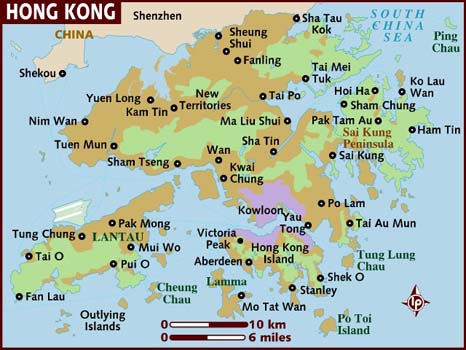
A chronology of events
See also:
&
this page on China giving masses amounts of information and analysis
&
this interesting Crimethinc interview with Hong Kong anarchists about events up until 22nd June 2019 and some of Hong Kong’s history and this interview published on September 20th with the same people: “Three Months of Insurrection : An Anarchist Collective in Hong Kong Appraises the Achievements and Limits of the Revolt”
&
The Meaning of Tiananmen, 1989
&
these texts written by anarchists based in Hong Kong in the 1970s
Although I (SF) am primarily responsible for this, it would have been impossible without the invaluable contribution of GD.

Graffiti:
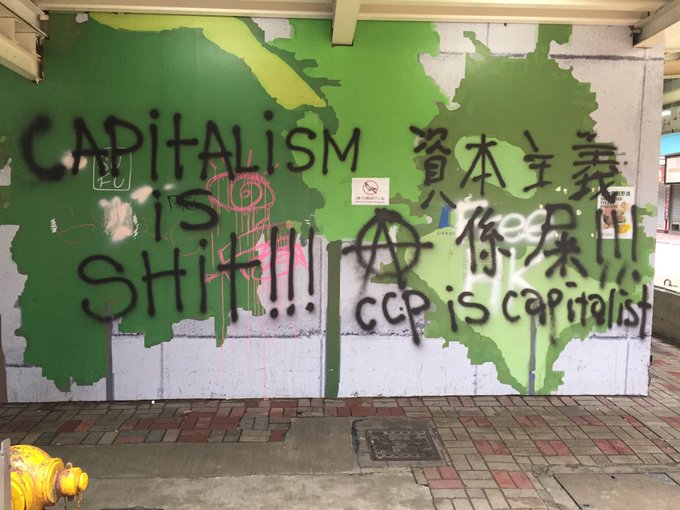
Left one painted near the Hong Kong Legislative Council, 18 August 2019
Right one painted 31/8/19 (CCP=Chinese Communist Party, for those who don’t know)
Chronology
For technical reasons, the chronology for September 2019 is now here and the chronology for august 2019 back to april 2011 has been placed separately here
Not everything here relates directly to Hong Kong – occasionally there are references to the technology of social control, opposition to which is one of the implicit reasons for this revolt, and to aspects of the situation in China or to developing totalitarianism elsewhere.
5/11/20:
Hong Kong launches national security crime hotline – WeGrass
6/9/20:
300 arrested on demo…cops thump 12-year-old
12/8/20:
How Hong Kong was lost
21/7/20:
1st anniversary of blatant cop brutality – 11 articles on cop abolition
“On July 21, 2019, a group of men in white shirts, wielding wooden canes and steel rods, laid violent siege to commuters on their way home from a protest. For 35 minutes, the police were nowhere to be found. The attacks revealed the collusion between the government, the police, and land owning triads benefitting from colonial land policies. Above all, it was a moment of collective trauma—a warning of the violence that was yet to come. …”
15/7/20:
Trump’s executive order confirms US State Department has trained the Hong Kong police
13/7/20:
Against emergency: The interlinked struggles in Hong Kong and the Philippines
6/7/20:
Elements of the new developments in totalitarianism applied to Hong Kong:
Hong Kong man accused of ‘terrorism’ under new Chinese law
Hong Kong protesters use ‘hidden language’ to dodge security law
“…residents are using wordplay and even subverting Chinese Communist Party dogma to express their frustration. On a bridge in the busy shopping district of Causeway Bay, a key spot for pro-democracy protests over the past year, traffic thunders past newly daubed graffiti that declares: “Arise, ye who refuse to be slaves”. The phrase is taken from the first line of China’s national anthem. And while the graffiti could conceivably have been written by a patriotic nationalist, it is most likely a declaration of dissent.”
The “Restructuring” of Hong Kong and the Rise of Neostatism
“The theoretical component of modern Chinese totalitarianism; contribution of the former Chinese “New Left”: old uses of Carl Schmitt” (X)
25/6/20:
Not thoroughly read this, but it seems interesting, though obviously limited by the generally eclectic ideologies of “Human Rights in China”:
The Crisis in Hong Kong: Xi Jinping Loots a Burning House
Commentary by Gao Wenqian
June 25, 2020
This commentary is available online: hrichina.org/node/27114
[Translation by Human Rights in China]
At precisely the moment when countries around the world are still focusing their energies on combating the pandemic of the century, and the situation in Hong Kong deteriorates by the hour, the Chinese authorities have seized the opportunity to announce a “Hong Kong National Security Law” at this year’s Two Congresses—the National People’s Congress (NPC) and Chinese People’s Political Consultative Conference (CPPCC). Prior to this, authorities had already delivered a one-two punch to remove possible obstacles to the law.
First was the pronouncement from the Director of the Liaison Office of the Central People’s Government in Hong Kong, Luo Huining, that Hong Kong has always been a national security weak spot for China, that “Hong Kong must not be allowed to become the breach for national security risks.” The statement was followed by the arrest of 15 pro-democracy activists, including eminent barrister Martin Lee and Apple Daily founder Jimmy Lai, by the Hong Kong police on accusations of participating in anti-extradition protests last year. Then, in mid-May, pro-democracy members of Hong Kong’s Legislative Council were ejected from the meeting of the House Committee, clearing the way for the reelection of pro-establishment legislator Starry Lee Wai-king as the chairperson of the Committee. At that point, Hong Kong fell into enemy hands completely, and “one country, two systems” was dead.
China’s shameless and brazen trampling on Hong Kong’s system of rule of law to force through the Hong Kong National Security Law is far from an impulsive act. Rather, it is part of a meticulous and careful plan. China intentionally concealed the facts of the coronavirus epidemic, causing a worldwide pandemic, incurring the wrath of the international community, and prompting a spate of international calls to hold China to account. Under siege at home and abroad, Xi Jinping, the helmsman of the Communist Party of China, decided he may as well go all out, wage a war against whatever may come while other countries are preoccupied, and settle the Hong Kong question once and for all.
Since the return of Hong Kong, the region has been a major source of concern for Beijing, that it will become the bridgehead for toppling the one-party system on the mainland. Ever since the blowback from the cross-border kidnapping of the Causeway Bay booksellers a few years back, Beijing has felt that Hong Kong’s rule of law under the “one country, two systems” framework has been a nuisance that must be gotten rid of. The fact that the anti-extradition movement waged so fearlessly by the Hong Kong people last year has not yet been quelled, coupled with, in particular, the big win by democrats in the district council elections last November, has been a source of great humiliation for Xi Jinping, bankrupting his “political strongman” image. In addition, if the upcoming Hong Kong Legislative Council elections turn out the wrong way, he could be held to account within the CPC. To be sure, the label of being the man who “lost” Hong Kong is not something Xi Jinping can bear.
Just as Xi Jinping was facing his political Waterloo in Hong Kong, he also made a mess in handling the new coronavirus outbreak in Wuhan. Both disasters stemmed from the imperative of maintaining stability—in order to “hold on to the CPC family legacy.” That imperative caused him to miss the window at the beginning of the outbreak to contain the spread, resulting in an epidemic ravaging the whole country, and then the rest of the world. Countries all over the world have suffered greatly. On May 18, 2020, at the World Health Assembly, the entire membership of the WHO, 194 countries—including China’s ally, Russia—passed a resolution to conduct an independent investigation into WHO’s handling of information of the epidemic in the early stages, a move prompted by the belief that WHO had helped China downplay the seriousness of the outbreak. Prior to this, China had steadfastly resisted the call for an investigation; but against overwhelming pressure, it had no choice but to sign on, while also trying to stall the efforts at the same time.
China has not been this isolated on the international stage since facing global opprobrium in the wake of the June Fourth crackdown on the 1989 Democracy Movement. This current problem has come to overwhelm all other issues at home, intensifying every other kind of domestic conflict, and severely straining social stability. To break through the diplomatic quandary, Xi Jinping, aside from continuing his two-fisted strategy of deploying both the hard “wolf warrior” diplomacy and the soft “checkbook” diplomacy—as means of dividing the international community and diffusing the pressure of accountability—is repurposing Mao Zedong’s old trick by adopting the “you fight your battle, I fight mine” strategy of preemptive strike. This is precisely his thinking in launching the offensive on Hong Kong. As he is outmatched, Xi seeks to avoid the enemy’s main forces by opening another front and moving to a new battleground of his own choosing.
Xi Jinping is likely to have assessed the consequences of this strategy: having already wronged the international community, there’s nothing left to lose, just like smashing an already broken jar, or getting one more bite when you’re already covered in fleas. But it is a gamble. If he manages in one fell swoop to solve the Hong Kong problem, then this victory would overshadow his hundred failures. And with this, he could transform his passivity into proactivity, and relieve the internal pressure he faces within the Party calling for accountability. China has always feared the U.S. response the most. That Xi dares to make such a reckless move obviously stems from his brash, combative, and hot-tempered nature. More important, Xi sees an opportunity to take advantage of the leaderless state of the international community. Since Donald Trump assumed the U.S. presidency, he has pursued a policy of isolationism and more or less completely done away with U.S. leadership on the world stage, to China’s great benefit. Xi’s wishful thinking here is that so long as he agrees to import U.S. agricultural products, he can pacify Trump. Even if he lets loose on Hong Kong and incurs strong repercussion from the international community, that repercussion would be more like thunder with little rain, not amounting to much. And in the end, it would be just like Russia annexing Crimea: it just happened.
On the question of national security legislation, although Xi Jinping wants to ram it through Hong Kong, violating the wishes of the people, he also knows he is in the wrong. That is why he does not dare to do it properly and let Hong Kong itself formulate the legislation in accordance with the requirement of Hong Kong’s Basic Law. Instead, in order to go around the Hong Kong Legislative Council, he had the Two Congresses authorize the National People’s Congress Standing Committee (NPCSC) to formulate the legislation, implementing regulations, and enforcement mechanisms, and have the Special Administrative Region government simply announce it and put it into effect. Mainland officials took care to argue that this is not legislation mandated by Article 23 of the Basic Law (a law that the “Hong Kong Special Administrative Region shall enact”), but legislation to be inserted into Annex III as provided in Article 18 of the Basic Law. Immediately afterwards, Hong Kong Chief Executive Carrie Lam expressed her support, saying that “it is the authority of the country to legislate on its own national security.” One can anticipate that before the Legislative Council elections in September this year, the authorities will vigorously promulgate implementing regulations of the national security law, which they will use to condemn pro-democracy representatives, and thereby intimidate the Hong Kong people and ensure the wished-for results of the elections.
This is a life-and-death contest. The Hong Kong people have already been pushed to the brink, left with no place of retreat, and are fighting the final battle. Just recently, the people of Hong Kong held their largest public demonstration since the outbreak of the coronavirus pandemic in a stirring demonstration of their will. The people of Hong Kong are suffering. The international community cannot just stand by and let China do as it wishes. China has torn up the 1984 Sino-British Joint Declaration and betrayed the promise of “one country, two systems.” Exploiting the ravage of the global pandemic, Xi Jinping is in effect looting a burning house, killing Hong Kong. What he is doing is nothing less than openly declaring war on the international community and making himself enemy of the world. As the saying goes, “A just cause finds abundant support, an unjust one finds little.” The international community should abandon its long-held policy of appeasement towards China, and firmly support the people of Hong Kong. The time for action has come.
This part of the chronology stops on 23rd March 2020 and is then resumed 3 months later on 25/6/20. Information for these 3 months is now on the global chronology of expressions of opposition to the Coronacrisis and subsequent events – Social Contestation 2020
23/3/20:
Petrol bomb attack at Hong Kong police married quarters
Hundreds commemorate 15-year-old Hong Kong student who died last September
22/3/20:
Yuen Long riot police take away many in repeated dispersals
16/3/20:
District councillor worker arrested after dispute over signs targeting gov’t supporters
8/3/20:
Cops seize homemade bombs, several arrests
29/1/20:
Clashes renewed on 6 months anniversary of cops beating the shit out of people in the underground
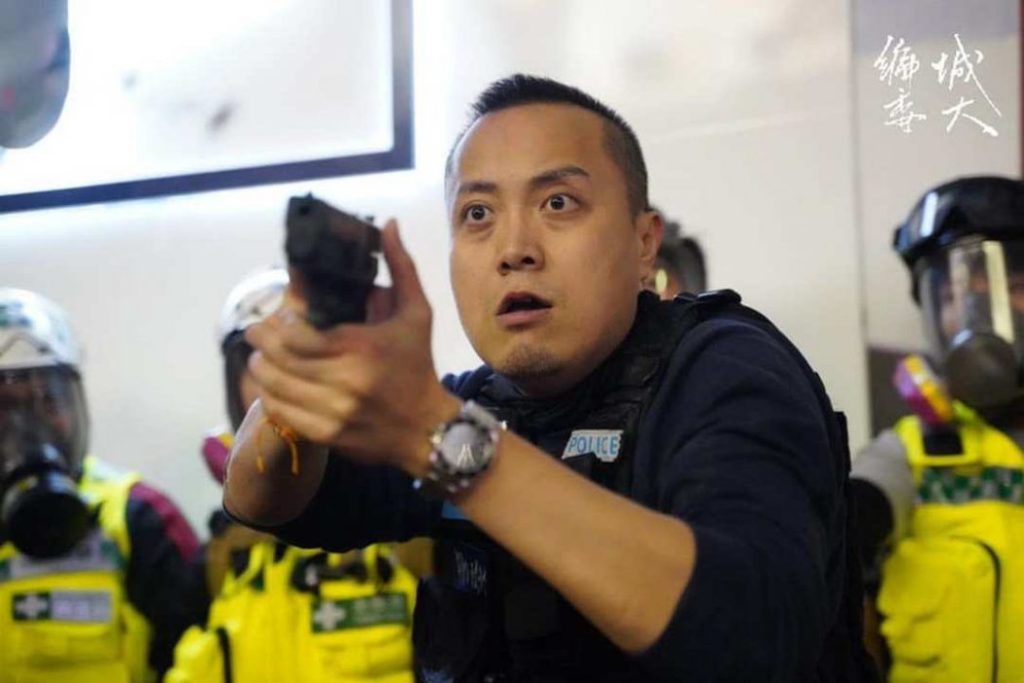 cop draws his gun saying the usual blah blah – “my life was threatened” by protesters throwing bricks, stones and bamboo sticks.
cop draws his gun saying the usual blah blah – “my life was threatened” by protesters throwing bricks, stones and bamboo sticks.
21/2/20:
Protesters celebrate cop’s Coronavirus infection with champagne & beer
“At the atrium of the Landmark shopping centre in Central, about 50 people gathered at 1pm, with some placing a dozen Corona beers on the ground to “celebrate the infection with the coronavirus of a police officer”.“Please feel free to take a beer and join our celebration,” a protester told passers-by.David Li, a protest co-organiser in his early 20s, said: “The police are now paying for their brutality in the past months in handling protests. We finally have something to be happy about amid the virus outbreak.””
19/2/20:
Anti-government protesters’ slogan spray-painted outside Chinese army base
15/2/20:
Barricades built, station torched, amidst anger over virus
“Protesters in Hong Kong returned to the streets at the weekend amid growing public anger over the city authorities’ handling of the coronavirus epidemic, with one group setting fire to a railway station and another damaging a local clinic. The protesters occupied Tin Sau Road in Tin Shui Wai district and built barricades with rubbish bins, wooden boards, foam boxes and debris to block multi-lane highways, the government said on Sunday. The demonstrations came after a group of people set fire to a ticket machine inside Tin Sau Light Rail (LRT) station on Saturday.”They even poured suspected flammable liquid onto the blaze,” the government said in a statement, adding that some protesters threw trash cans onto a track while a train was passing through in the other direction. Riot police were dispatched to the scene, where they surrounded around 20 black-clad protesters and ordered them to remove their masks and show their ID, firing pepper spray at them. At least 14 people were arrested. The government said the incident happened after an earlier, peaceful demonstration had ended.Riot police also gathered in Fo Tan, in the New Territories, along with an armored vehicle and a water cannon, ahead of a planned demonstration on Saturday afternoon. Another group marched in Tai Po against plans to use the local Tai Po Jockey Club primary care clinic as a center for “mild” COVID-19 cases, chanting slogans calling on the government to close down the city’s border with mainland China. They told reporters that there had been no consultation with local residents about the clinic before the plan was announced.”
12/2/20:
Arrests following road blockades
10/2/20:
Teachers who criticised government on social media say they are living in fear
7/2/20:
Thousands of doctors and nurses hold sit-in at Hospital Authority asking for negotiations on last day of strike; officials refuse to meet them
See also these reports:
Coronavirus: Hong Kong medics escalate strike to demand a full shutdown of Chinese border
Hong Kong Free Press, February 4, 2020
Hong Kong’s Striking Health Workers Pose New Threat to Beijing
Bloomberg, February 3, 2020
6/2/20:
Report on large increase in those joining Trade Unions
If course, this is not at all to defend the collaboration role of Trade Unions, but it gives the lie to those who dismiss the movement in HK as merely concerned with bourgeois democracy and not daily life issues such as wages and working conditions.
19/1/20:
Further clashes (videos & links)
16/1/20:
Lam tries to calm movement with apparent concession
“Hong Kong’s leader has said that the “one country, two systems” framework under which the city enjoys freedoms unknown in China could continue after the 2047 deadline if loyalty to Beijing is upheld.” The operative word is “could”.
State falls months behind on its tax collection
Investment in commercial property falls 52%
10/1/20:
Arrested public sector workers suspended from work
8/1/20:
Clashes as protesters mark 2 month anniversary of student’s death
5/1/20:
Police station molotoved, demo attacking mainland traders pushing up HK prices
1/1/20:
Happy New Hour!
“…crowds of protesters in the Mong Kok district set fire to barricades, before riot police unleashed 2020’s first volleys of teargas in response. Shortly before the final day of 2019 drew to a close, police had used water cannon to disperse protesters in the same area while, in the nearby Prince Edward neighbourhood, officers arrested several protesters staging a candlelight vigil.”
400 arrested
“…protesters had blocked roads with barricades, dug up bricks from pavements and set fires to banks and cash machines.”
26/12/19:
3rd day in a row for the much-malligned malladjusted and mallnourished…cop till you drop
“Riot police stormed shopping malls for a third day of Christmas protests in Hong Kong on Thursday and detained a number of people after masked protesters roamed through shops, some throwing paint and disrupting restaurant services. Christmas in Hong Kong is usually bustling with commercial activity, tourists and local people flocking to shops and restaurants and strolling on both sides of the scenic Victoria Harbor to watch festive illuminations. But during this holiday, streets and malls in shopping districts are filled with tension, after police fired tear gas, rubber bullets and pepper spray at protesters and beat and arrested many of them. They also conducted indiscriminate stop-and-search procedures on shoppers, passersby and journalists during the past three nights. On Christmas Eve, protesters blocked roads, vandalized businesses seen as pro-government and threw sporadic fuel bombs but protests on Christmas and Boxing days were less intense. On Thursday, hundreds of mostly black-clad protesters shouted slogans and marched through several shopping malls across the city in response to online calls to disrupt business”…
Video: riot police attack undercover police by mistake
24/12/19:
HSBC vandalised and more
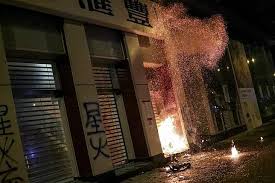 Heat Sparks Blazing Combustion: Merry Firemas!
Heat Sparks Blazing Combustion: Merry Firemas!
500 Hong Kongers rally in support of deported Indonesian domestic worker
Contradictions facing CCP – massive exodus of “Han” from Xinjiang, the Uighur region
X writes:
Apparently the Japanese media are saying things that haven’t seen the light of day yet in English: it is said that senior CCP officials are unhappy with Xi Jinping because he hasn’t been firm enough in Hong Kong to restore “stability”…and now that we have seen what “stability” looks like in Xinjiang, it’s kind of difficult to imagine that that would be a preferable situation either. Could be that the Chinese bureaucratic capitalism of the present era has just encountered its built-in structural limits, as it did in earlier epochs, but with the difference that this is all occurring on a far greater scale,, with possibly even greater negative consequences when the crash, whether economic or social, comes. HK is putting the pressure on in a positive way, and Xinjiang in the negative, and together they define the present boundaries of the bureaucratically possible.
21/12/19:
More HK Christmas shopping (though in fact, the 21st December is Saturnalia, not Christmas)
18/12/19:
Shanghai (mainland): student flashmob calling for free thinking
Anywhere else this would be uninteresting and unexceptional…
15/12/19:
Christmas shopping Hong Kong-style
13/12/19:
Unusual chink in China’s social media control
“An online campaign against the alleged mistreatment of an ex-employee at Huawei in mainland China is drawing inspiration from the Hong Kong protests in a development that is likely to concern Beijing. After news of the alleged wrongful detention of a former employee of the telecoms equipment group went viral on social media in China last week, users published more than 20,000 posts drawing parallels between the Huawei situation and Hong Kong, Financial Times analysis showed. While China has a vibrant social media scene, the posts on Huawei represent the first sustained campaign in the country to draw on the Hong Kong protests. One popular post by Chen Youxi, a prominent Chinese lawyer, said the case of Huawei ex-employee Li Hongyuan, who was detained for 251 days after a labour dispute, showed that Hong Kong people were justified in their opposition to a proposed extradition law that sparked the protests… the emergence of some posts relating to the Huawei situation with Hong Kong represents an unusual departure from the official line… In some of these posts, disgruntled mainland Chinese social media users repurposed one of the key slogans of the Hong Kong protesters: “five demands, not one less”, referring to the five things the territory’s demonstrators want from the government, including an independent police inquiry and universal suffrage. An online post titled “eight demands, not one less” began circulating on mainland Chinese social media, calling for among other things an independent investigation into the actions of Huawei and the Shenzhen police.”
World Bank tells Taiwanese staff to get Chinese passports
The President of the World Bank is a former Under Secretary of the Treasury for International Affairs under Donald Trump
12/12/19:
Despite cop attempts to prevent them, almost 600 middle school students rally to show support for arrested fellow classmates, vowing to continue rallys “until we win”
Health care activist rally threatens government with strikes from new trade unions
Not intended as an endorsement of trade unions but as yet another factor in the struggle to be unravelled. According to this on the 11th 1,800 doctors and nurses rallyed to encourage unionization, and discussed participating in a general strike. And there’s this report about unions, both new and old, on a recruitment drive.
11/12/19:
Subway station and shop molotoved, ticket machines vandalised, buses forced to stop
10/12/19:
Report in Mandarin on growth of HK trade unionism and the belief that the way forward is through better and more extensive strikes, modeled partly on Solidarity in Poland 1980-81, as well as S.Korea
Court of Appeal rules mask ban to remain unconstitutional
8/12/19:
6-month anniversary of movement sees 800,000 people on streets, but sadly little to no theoretical development despite other developments
A friend wrote: “…there is a tendency becoming manifest that seems to think it can put off the theoretical moment (what some of these people call “ideology” a description which shows more confusion than ought to be found in a movement this developed) in favor of advancing tactics under the condition of avoiding or delaying the inevitable collision with practice and its consequences in class society – typically in the interest of maintaining a tactical unity. This failure to advance critical theory at a time when the movements themselves are at high tide can only mean that once again the owl of Minerva will fly when the revolt is past its pull-date, and the blood of revolutionaries has already started to flow in thick gouts. This looks like a global problem – HK, the belt from Lebanon to Iran and the Andean movements, and … with the Gilets Jaunes, in France as well….” In this epoch – the last slim chance for a global revolution before ecological catastrophe kicks in – consciousness has never been so retarded, despite some excellent social contestation. It’s going to require some significant degree of risk as well as the effort of up-to-date analysis commensurate with the desperate times to make the voices of those who claim to want a libertarian revolution heard and to potentially influence breaks with the constraints of dominant ideology amongst those struggling against the miserable future capital is holding out for them.
Report from the World’s Biggest Black Block
Account of some of the most important moments in the history of what’s been happening: “…we lay out a brief timeline of the movement’s defining moments, why tensions are so high in the Pearl River Delta, and what tactical and strategic lessons protesters elsewhere can take from this. We will not evaluate the movement based on its ideology, but instead describe how it has provided the basic arsenal and grammar for the future of struggles against the techno-authoritarian surveillance systems to come.”
5/12/19:
Another report on teargas and how protesters are having to deal with its toxic effects…This says 16,000 teargas cannisters have been fired in 6 months
Remember – a teargas cannister can contain about 20 teargas pellets – ie 320,000 teargas pellets in 6 months – ie averaging about 1800 pellets a day. See 20/11/ and 14/11/ reports below for more on the terrible toxicity of this teargas.
4/12/19:
Now no need to go out into the streets – riot in the comfort of your armchair
“In societies where modern conditions of production prevail, life is presented as an immense accumulation of spectacles. Everything that was directly lived has receded into a representation.” – here
And now Beijing (probably) has issued a counter-riot video game called “fight the traitors together”
“Arguably the most unsavoury aspect of the game, made with the Cocos Creator game development tool, is a cartoon showing Western-looking types offering cash to protesters. They promise large sums for killing police officers and more for committing suicide. It’s not clear who produced the game, which does not feature creator credits and is hosted on a standalone website. Nothing connects it directly to the ruling Chinese Communist Party (CCP), although Chinese state media was quick to report on its existence despite the game having very little presence on China’s dominant social media site, Weibo. The Global Times, a CCP-controlled newspaper regularly used to disseminate propaganda about the Hong Kong unrest, ran a gleeful news story about the game. It quoted one player as saying: “The practices of these modern traitors have long been irritating. While they are free in real life, at least in the game they should pay for what they have done.””
3/12/19:
Cops break law horror shock!
2 students sentenced to “correctional training” & ordered to pay US$36,500 for vandalising 3 rail stations
Although the magistrate who sentenced them said their actions had stopped people using the railway, in fact it was the company that closed the railway because they couldn’t make money out of these people nor could they surveille them – all the students had done was vandalise the ticket machines and spray-paint the security cameras.
Report on how Beijing can tame movement
The other side of the coin of democracy becoming more totalitarian is totalitarianism having to become more ‘democratic’. What Debord called “the integrated spectacle” (where the diffuse and concentrated forms of social control are superceded by an integrated mix of the two) could very well be intensified in Hong Kong by a movement that doesn’t want to make waves amongst its participants and thus succumbs to a ‘democratic’ ideology that will merely intensify social control whilst increasingly providing compensations for this suffocating alienation. A class struggle which persistently refuses to see itself as a class struggle will invariably end up reinforcing the power of the ruling class, its state and its economy.
2/12/19:
On the mainland in Guangdong there’s a temporary victory for protesters against crematorium construction
“Last week’s clashes in Huazhou’s Wenlou township, some 100 kilometers (60 miles) from Hong Kong, saw around 1,000 armed riot police take over the town after residents made barricades on the streets to block the passage of armored vehicles. Social media posts showed a line of overturned police cars, while eyewitnesses said younger people had hit back at incoming police lines with projectiles. Dozens of people were beaten and detained before police regained control of the area, according to local media reports and eyewitness accounts. Media reports said some demonstrators were chanting slogans similar to those heard across Hong Kong, including “Revolution now!“
Pro-democracy “opposition” bureaucrats present bill to reduce riot penalty from 10 to 3 years, and unlawful assembly penalty down to 6 months
How nice of them.
Workers in advertising industry say they’ll strike this week
Cop waterboarding someone they’d arrested?
1/12/19:
Barricades erected, pro-China stores trashed as protests ascend into order…More here
Report on violence
“A number of mysterious deaths have surfaced in Hong Kong over the past few months in which the corpses were suspiciously found in the water, unclothed, or without identity. Hong Kong government officials have acknowledged that the rate of suicides and discoveries of dead bodies has increased. At press conferences, the authorities have acknowledged that some police officers had impersonated protesters, and some officers who left the force said that police behavior had gotten out of control. “
25/11/19:
15-year-old sentenced to “rehabilitation centre” for carrying laser beam torch on protest
“The Rehabilitation Center hopes that the defendant can make corrections through vocational training and psychological counseling.” Sounds like a less intense less brutal version of the Xinjiang “vocational training centres”.
24/11/19:
Could this election derail the concrete direct struggle in the streets and elsewhere?
Whilst it’s obvious that this vote was mainly delivered in order to make things awkward for Beijing and its loyal lapdogs, Beijing is playing a sometimes subtle slow long-term game that can only be helped if people rest on the laurels of a purely electoral victory. As the Made in China Journal said, “we should not hold our breath waiting for a single dramatic event or for the authorities in Beijing to formally announce the end of Hong Kong as we know it. Hong Kong’s assimilation into the mainland governance regime will most likely be accomplished subtly and through systems and infrastructures that are already well developed. As such, opposing Beijing’s growing influence in Hong Kong is not enough. It is also necessary to critically examine the structure of governance in the city and to identify the existing structures that are facilitating Hong Kong’s ongoing transformation. ”
22/11/19:
Mask ban temporarily reinstated
Man arrested for taking photos of cop training
“The 43-year-old was on Friday arrested in Kwun Tong on suspicion of obstructing police officers from executing their duties, the force confirmed. He was accused of using a mobile phone to record officers in the middle of their operation on Sunday at the Hong Kong Museum of History, near Polytechnic University (PolyU), as well as uploading the picture on social media… The offence carries a maximum penalty of two years’ imprisonment.”
Report in Mandarin on mental state of those still inside University, more than 30 trapped, some panicking, refusing to eat, losing language ability
Polytechnic University – still a few left inside trying to escape the cops
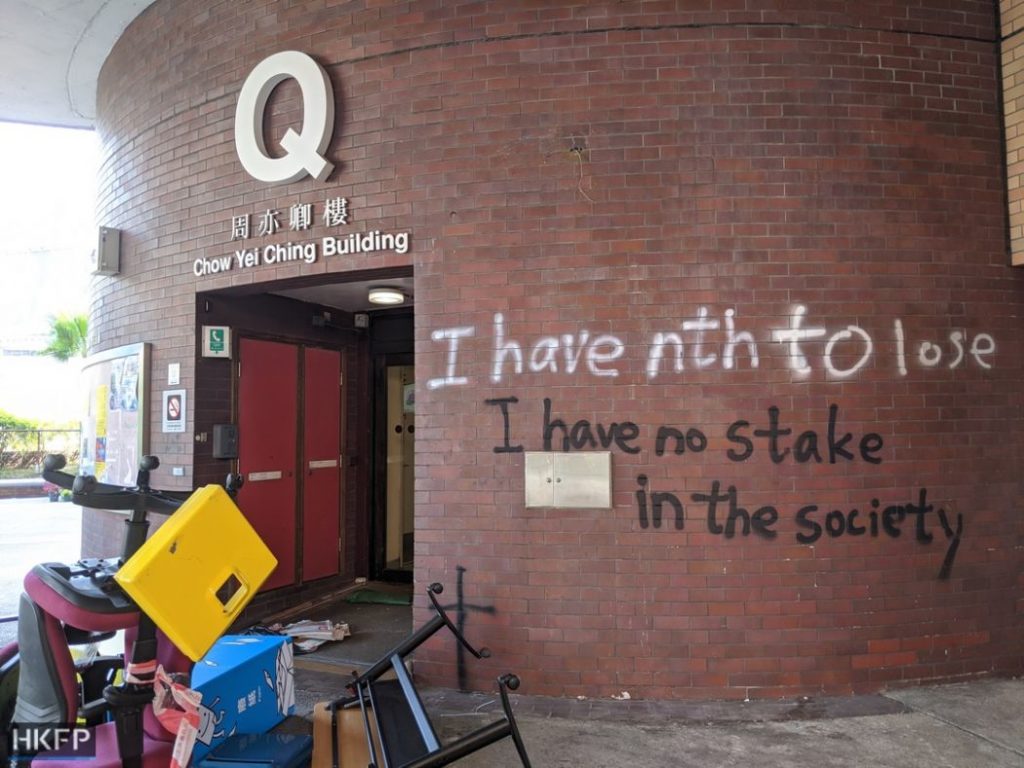 Polytechnic University graffiti
Polytechnic University graffiti
A lot of the students have left the siege in a highly stressed and emotional state, not just caused by exhaustion and hunger but also the inevitable product of putting oneself in danger of arrest and cop beatings or worse and just the tension of having confronted significant social contradictions. But after a period of time often this settles into a sense of strength at having dared to risk oneself against a society that pacifies all emotions and desires – particularly if this emotional state and its more general implications is later theorised, articulated. The likelihood is that, long-term, they’ll have a far stronger sense of self and of community and of reality than all those who avoid such risks, who prefer to sleep-walk their way to dusty death by avoiding participating in the great gamble of history. If you stay cool and never burn you’ll never turn to ash, if you lick the boots that kick you then you’ll never feel the lash, if you crawl along the ground at least you’ll never crash…
21/11/19:
Public sector workers unions say they’ll strike on 17th to 19th December to demand independent enquiry into cop violence
High school students hold sit-in in front of school’s gate after cops had entered school and clashed with students the day before
Report on fake news
“I just assume everything is fake until I have seen sources from both sides and more than two news agencies I trust are reporting the same,” Hong Kong resident Michael Wu, 27, told AFP. Opposing camps are locked in “echochambers” of misinformation online, said Wu…“People on each camp only ‘fact check’ sources within their own echochamber,” Wu said. “Even when the truth is out, people are also ready to believe in whatever fake news that would advance their cause or ideology.””
20/11/19:
Government’s cleaners sent out to work without proper gear for tear gas toxins
For more on these teargas toxins, see report for 14/11/19 below.
19/11/19:
United Nations supports Hong Kong cops
A spokesperson for the UN Office of the High Commissioner for Human Rights (OHCHR) castigated the “extreme violence” committed by young protesters in Hong Kong, “including against the police force.” While acknowledging that “[t]he vast majority of the people of Hong Kong have been exercising their right of freedom of assembly peacefully and in accordance with the law,” the spokesperson went on to state that “the authorities have by and large respected the exercise of this right.” Hardly a surprise from the ruling class organisation that bombed the shit out of Iraq back in 1991 (see, for example, this).
Lawyers suggest that Beijing’s overruling of HK court’s decision to declare mask ban “unconstitutional” is beginning of the end of “One country – 2 systems” More here
This confirms what was written in this Vice article from 14th November:
” At the fourth meeting of the 19th Central Committee of the Communist Party of China in October, Xi made it very clear that he wanted to tighten his grip on the former British colony at any cost. The communique from the meeting said Beijing planned to “control and rule” Hong Kong using “all the powers vested in [it] under the constitution and the Basic Law,” the mini-constitution that defines Hong Kong’s status. It added that it will “build and improve a legal system and enforcement mechanism to defend national security” in Hong Kong. To achieve this goal, Beijing is employing a wide array of tactics, according to Ni, including propaganda, threatening messages, militaristic shows of force, infrastructure projects, and punishing Western companies for supporting the protests (including the NBA and Apple). By continuing to pressure Lam and the Hong Kong authorities to come down harder on protesters, or possibly enact the emergency legislation, Beijing can continue to appear to be taking a back seat, all the while implementing its long-term goal. “Though the details of the plan have yet to be worked out, it seems evident that China’s leaders intend to gut the Basic Law, exercise more direct control over the appointment of key officials, weaken or eliminate Hong Kong’s judicial independence, curtail civil liberties, and suppress political dissent, including through ideological indoctrination,” Pei said. “In other words, they have decided effectively to abandon the “one country, two systems” model, which Deng Xiaoping promised to uphold for 50 years after Hong Kong’s return to Chinese rule in 1997.”
18/11/19:
People from rest of Hong Kong march on cops laying siege to university from behind their lines…whilst others occupy cops in other parts of HK…as some break out of university siege
More here
“Witnesses have remarked that some protesters have been suffering from burns from chemicals in jets fired from police water cannons…Police have admitted firing three live rounds when “rioters” attacked two officers who were attempting to arrest a woman. No one was wounded and the woman escaped …The city’s Cross-Harbour Tunnel, next to the Polytechnic university, linking Hong Kong island to the Kowloon peninsula, remained closed after protesters torched a bridge above the toll booths on Sunday. Some train services and many roads across the Kowloon peninsula were also closed. All schools remain shut. As police approached the barricaded front gate of the university before dawn, protesters retreated into the campus and started fires at the gate and a footbridge.”
100s trapped on campus as cops lay siege to university; High Court rules face mask ban unconstitutional …which Beijing overrules
“Hong Kong police have trapped up to 800 people inside a university in the city, firing tear gas at any protesters trying to escape the campus…Hundreds were still trapped inside on Monday morning, following overnight clashes at Polytechnic University during which protesters launched petrol bombs and arrows at police who threatened to begin using live rounds. When a group of protesters tried to escape the campus on Monday, police fired tear gas at various exits, preventing them from leaving. Earlier, the university’s president, Teng Jin-Guang, had urged protesters to leave, saying the police had agreed to a ceasefire on the condition that protesters stopped their attacks. Tang Siu Wa, 41, a volunteer with the Protect the Children group, who has been at the campus for the past two days said about 800 people were trapped inside the school, searching for ways out. “Officially, they are saying people have to leave now, and even pointing out some ways to let you out. But when people try to leave that way, they contain them. It’s a set-up,” she said. “They don’t let anyone on the university campus go.” Tang said the group was exhausted and facing dwindling supplies of food and water. Some peaceful protesters want to leave while others want to stay. “People getting tired but they don’t want to surrender.”…On Monday, Hong Kong’s high court ruled a ban on face masks implemented by the government under an emergency regulations ordinance enacted in 1922, as unconstitutional…Police had earlier issued a statement ordering everyone inside the university to “drop their weapons”, remove their gas masks and leave.”
More here
you knew that we would meet again if your memory served you well.
17/11/19:
German army trains China’s PLA
Given that Joshua Wong’s main political stance is support for democracy and a desire to seek help for Hong Kong from Western states, he clearly has to denounce this complicity in order to give some semblance of coherence to show to those who would potentially vote for him. But as with Trump’s complicity with Beijing, and the UK cops helping the Hong Kong cops, seeking help from various states has no coherent basis whatsoever.
University – clashes continue More here
“A Hong Kong police officer was hit in the leg by an arrow and protesters set an overhead footbridge on fire Sunday as they fought to keep police using tear gas and water cannons from advancing on their university campus stronghold. Police said the arrow struck a media liaison officer in the calf and he was taken to a hospital. Photos on the department’s Facebook page show the arrow sticking out of the back of the officer’s leg through his pants. As riot police moved in from all sides, some protesters retreated inside Hong Kong Polytechnic University while others set fires on bridges leading to it. A huge blaze burned along much of a long footbridge that connects a train station to the campus over the approach to the Cross-Harbour Tunnel, a major road under Hong Kong’s harbor that has been blocked by the protesters for days. The use of bows and arrows, along with a gasoline bombs launched with catapults, threatened to escalate the violence in the more than five-month-long anti-government movement…A large group of people arrived in the morning to try to clean up the road but were warned away by protesters. Riot police shot several volleys of tear gas at the protesters, who sheltered behind a wall of umbrellas and threw gasoline bombs into nearby bushes and trees, setting them on fire. The protesters held their ground for most of the day, as water cannon trucks drove over bricks and nails strewn by protesters to spray them at close range — some with water dyed blue to help police identify protesters afterward. Protesters began retreating into the university near sunset, fearing they would be trapped as police fired tear gas volleys and approached from other directions. The protesters have barricaded the entrances to the campus and set up narrow access control points. They are the holdouts from larger groups that occupied several major campuses for much of last week. Another group threw bricks in the street to block a main thoroughfare in the Mongkok district, as police fired tear gas to try to disperse them. The disruption to Nathan Road traffic may have been an attempt to distract police during the standoff at Polytechnic.”
16/11/19:
Politician’s Liberation Army tries out presenting a benevolent image
X writes: “This is all too reminiscent of the way the PLA insinuated itself into Beijing in the days preceeding the June 4th massacre.” SF writes: “Maybe, but I somehow doubt that it’ll take the form of a Tiananmen Square-type massacre – more a slow advancing pressure, with mass arrests, increasing use of triads, economic manipulations, maybe even a state-sponsored terrorist bombing – all to give the PLA an image of intervening in order to create stability in the mounting chaos.”
More detailed analysis of this propaganda stunt
15/11/19:
Solidarity from Chinese on the mainland
Latest information
“Protesters at the Chinese University set fire to an abandoned van on a bridge over the Tolo Highway on Friday night, as they retreated back inside the university campus. The vehicle was part of a barricade on the bridge, where protesters were preparing to repel police and throw objects down to block the highway. Firefighters extinguished the blaze shortly before 10pm. They also blocked the Tolo Highway again after it was partially reopened for about seven hours, following the government’s refusal to accept their demands. “
70-year-old street cleaner dies after being hit by brick
Although the government has said he was killed by a rioter (well, they would, wouldn’t they?), this story says that this was a fight between 2 different groups. This from the Hong Kong Women Workers Association and Cleaners’ Workers’ Union (in Mandarin) says that the state and/or the company may refuse the guy’s family compensation because the man was in his lunchbreak and being an outsourced worker meant that he wasn’t entitled to compensation, even though it’s impossible to say whether he was taking his lunchbreak or not. What a wonderful world!
14/11/19:
Report on suspected dioxin in teargas causing incurable diseases and skin deterioration (Stand News reporter diagnosed with incurable Chloracne after exposure to dioxins released by tear gas)
(see photo below)
This report is in Mandarin, so a Google Translate is limited and a bit confused, but here is part of it, making comprehensible the bits that were slightly perplexing, hopefully without changing the meaning:
“ Patients with chloracne are still suffering from pus after several decades. But the most frightening thing is that chloracne represents a considerable concentration of dioxin in your body (but not fatal)…Ingestion of dioxin-like levels above the threshold may also cause cancer and pose other health risks, such as damage to the immune system, affecting endocrine balance, and pregnant women at risk of miscarriage or birth, even through the mother infant infection (including blood and breast milk), can pass the dioxin-like to the next generation….high concentrations of dioxins can have adverse effects on infant development such as body weight, language, cognitive development, and small muscle utilization… the temperature after the tear gas is emitted exceeds 400 degrees Celsius (400 degrees is the highest measurement temperature of the measuring instrument, that is, the combustion temperature of the tear gas bomb is higher than 400 degrees). At such high temperatures, the main component of the tear gas bomb CS will release dioxins, which can enter the body through skin contact, food, water and air. Skin contact is an important route of contact for journalists who work on the front line and are exposed to a tear-filled environment. In this way, even with protective equipment such as a mask or a respirator, the body cannot avoid intake of dioxins. But what worries … a lot of scholars is that the dioxin-like bacteria from the teargas can pollute plants, soil surface and sediment in the water. If onshore and marine organisms ingest contaminated plants, soils and sediments, they will accumulate in the food chain for decades. When we eat contaminated seafood, meat, and vegetables, the dioxin enters the body through the digestive system and poisons us. In the past five months, teargas smoke has been everywhere in Hong Kong. On November 12 alone, 1,567 tear gas bombs were fired across Hong Kong, bringing the total to 7,500. The 18 districts were not spared, and many tear gas bombs fell on the side of the market, near the supermarket, polluting all food. The SAR Government has not detected the toxins in these contaminated foods and has not reminded the public of its potential disasters. If Hong Kong people eat or inhale harmful substances in this way, they will remain in their bodies and in their children’s bodies for decades to come. Toxic substances will also destroy Hong Kong’s ecological environment and will plague it for decades. Finally, we must remember that the Hong Kong SAR Government still fails to understand the chemical composition and derivative compounds of the tear gas bombs , and its long-term mental health effects on the human body, because it is difficult for the scientific community to know the residual time of these chemical poisons, or if the impact on the environment will be greater …We call on the SAR Government to stop this humanitarian disaster and to ban the use of tear gas before it has made clear the possibility of disaster.“
Beijing’s Department of Health says tear gas chemical ingredients should not be disclosed because it would “affect police deployment,” whilst claiming carcinogenic dioxins came from fires started by protesters
Well, they would wouldn’t they?
Injustice minister attacked in London
Report on recent clashes at universities, including today
“The university remained barricaded by demonstrators on Thursday, with roadblocks and brick walls at the schools various entrances. Protesters also occupied a bridge that leads into the campus. Police have accused the university of being a “manufacturing base for petrol bombs and a refuge for rioters and criminals” after some protesters fired burning arrows – taken from the university sports centre – at officers and threw 400 petrol bombs. Police fired more than 1,500 rounds of tear gas and more than 1,300 rubber bullets at the demonstrators. The city was paralysed, with much of its public transport suspended and all universities closed. Several universities have cancelled classes for the rest of the semester or moved lectures online. Hong Kong’s Education Bureau has suspended classes at primary and secondary schools for Thursday because of violence and described the situation in the city as “chilling”. The bureau also appealed for “school children to stay at home, not to hang around in the streets, to stay away from danger, and not to participate in illegal activities”.
12/11/19:
High school students rally against police violence: “I can’t live with my conscience if I keep on living like normal after everything that happened” (report in Mandarin)
Report on gang rape by cops of arrested woman
Underground stations closed, university classes stop
Clashes at university…Photos of university clashes here
Central Business District wreaks of havoc
“More than 1,000 protesters, many wearing office clothes and face masks, rallied in the Central business district for a second day, blocking roads below some of the city’s tallest skyscrapers and most expensive real estate. …Universities and schools cancelled classes, with students, teachers and parents on edge a day after police fired tear gas and students hurled petrol bombs on some campuses. “
Why mainland China hasn’t intervened militarily so far
This largely misses out anything more complex, as pointed out by Made in China Journal which has said, “we should not hold our breath waiting for a single dramatic event or for the authorities in Beijing to formally announce the end of Hong Kong as we know it. Hong Kong’s assimilation into the mainland governance regime will most likely be accomplished subtly and through systems and infrastructures that are already well developed. As such, opposing Beijing’s growing influence in Hong Kong is not enough. It is also necessary to critically examine the structure of governance in the city and to identify the existing structures that are facilitating Hong Kong’s ongoing transformation. ” – from an article on pages 13 – 16 (it’s definitely worth reading this article to get, amongst other aspects of the situation there, some insight into the contradictions of Hong Kong’s NGOs and social workers, and those who aim to participate in such things).
11/11/19:
Clashes rage for over 16 hours (a fairly detailed account of many of the actions of the day)
Protester in critical condition after cops shoot him at close range
“The incident occurred during a citywide strike. Protesters had been blocking roads at an intersection outside Tai On Building in Sai Wan Ho. At around 7:15am, a police officer tried to give chase to multiple masked men before he pulled out a service pistol and pointed it at them, according to a live stream by Cupid Producer. He then grabbed a protester in white and shot another protester in black at close range….Parts of Hong Kong ground to a halt on Monday as protesters tried to disrupt the morning commute as part of a wider plan to mobilise a general strike. Arrests were made in Tuen Mun, Wong Tai Sin and Sha Tin. MTR services were disrupted on the Kwun Tong Line, Tung Chung Line, East Rail Line, and the Ma On Shan Line. Light rail services were also affected.”
More here and here
“At Polytechnic University in Hung Hom, police fired tear gas at protesters who were throwing petrol bombs from a footbridge. At the Chinese University in Shatin, police fired rubber bullets at demonstrators. In Wong Tai Sin, protesters dug up bricks and threw them onto a main road to block traffic. Earlier, police said protesters had blocked the Cross Harbour Tunnel, linking Kowloon to Hung Hom, and had lit fires in Shatin and Tuen Mun, obstructing traffic. Several mass transit railway (MTR) lines were delayed or suspended as some protesters were seen smashing gates at MTR stations. At least two universities have cancelled classes for the day…”
Motorbike cop deliberately rams into protesters
10/11/19:
Further clashes
8/11/19:
Student who fell from car park dies
Clashes in response to student’s death
“The centre of violence was on Nathan Road, in the Kowloon district of Mong Kok, one of the most densely populated locations in the world, where activists built barricades and trashed an entrance to the metro station…UST students trashed a campus branch of Starbucks, part of a franchise perceived to be pro-Beijing, and rallies are expected across the territory over the weekend. “Condemn police brutality,” they wrote on the restaurant’s glass wall…In Mong Kok, dozens of activists barricaded off Nathan Road, which leads to the harbour to the south. They vandalised a closed metro entrance, throwing in bricks and pouring oil through the metal grill, and destroyed a phone booth in a small explosion. There were clashes and fires in the New Territories town of Sha Tin.In Tseung Kwan O, where people had been leaving flowers and silently crying for hours, people screamed encouragement and abuse after a traffic light was set on fire. …The university called for an independent investigation into Chow’s death, saying an ambulance was blocked by police cars and ambulance officers had to walk to the scene, causing a delay of 20 minutes…Protests scheduled over the weekend include rallies in shopping malls, some of which have previously descended into chaos as riot police stormed areas crowded with families and children. Protesters have called for a general strike on Monday morning and for people to block public transport. Such calls have come to nothing in the past. Last weekend, anti-government protesters crowded a shopping mall in running clashes with police that saw a man slash people with a knife and bite off part of the ear of a local politician.”
6/11/19:
Another day, another courageous attack
“The pro-Beijing lawmaker Junius Ho has been attacked in an apparent stabbing…The man could be heard shouting in Cantonese: “Junius Ho, you scum!” The attacker was arrested by police”
On July 21st – 22nd, over 100 armed men dressed in white indiscriminately attacked civilians on the streets and passengers in the Yuen Long MTR station including the elderly, children, black-clad protesters and others. At least 45 people were injured in the incident, including a pregnant woman. After this attack Junius Ho was videoed greeting the white-clothed group of assailants, shaking their hands and calling these triad gangsters “heroes”, giving them thumbs-up and saying to them “thank you for your hard work.” At least one of the white-clothed men who shook hands with Ho has been shown to have been inside Yuen Long Station during the attacks. Ho defended the attackers at a press conference by saying that the incidents were a “normal reaction to protesters who brought violence to the peaceful community after they stormed the liaison office” and also praised them for “safeguarding” their district. He also said, “We can’t pardon the sin, but we can pardon the sinners.” His office was subsequently vandalised by the protesters after the attack. A glass partition was broken, and a memo was left that “suggested a link between the violent gangs that carried out the attack the previous day and the police force”. Protesters also posted anti-government sticky notes on the exterior wall of his offices in Tin Shui Wai and Tuen Mun. His parents’ graves were covered with graffiti. This piece of scum thinks his words have no consequence. Well, they now have – for him and for the brave guy who was immediately arrested after the attack. This report says that “Before the attack, the man [who stabbed him] thanked Ho for his hard work”, a clever quote from Beijing’s Ho himself, who back in July had thanked the triad scum who’d badly beaten up train passengers for their “hard work”.
X writes: “I’m sure that there will be retaliation both by the triads … and Beijing, to whom he was certainly a useful local proxy. Nonetheless, for many of those who have been attacked by the real terrorists in Hong Kong – the cops and their triad friends – and suffered at their hands, this is a welcome proof that the people of Hong Kong are not defenseless against their oppressors and that what goes around eventually comes around. The object of the exercise for some time on the side of the Beijing’s viceroy and her allies in the Legco and business elite, has been to criminalize, and then dispose of, the opposition, in the halls of government and especially on the streets. This attack will hasten the imposition of more drastic measures [not to call them “draconian”- as if Draco had anything on Qin Shi Huang Di but a few years], reminiscent of the earlier days of the CCP dynasty, as well as give a perfectly good illustration of the kind of actual criminality the official organs of the “one state two systems” colonial government is protecting. And the stakes everywhere else will multiply porportionally to the seriousness of events in Hong Kong. The degree to which the official world and the worlds outside it and against it are collaterally affected will show the extent to which the global movement already underway against austerity, authoritarianism and inequality is capable of mutual support and solidarity, while showing by example, one day in Chile and the next in Lebanon or Iraq, the way forward.”
5/11/19:
Riot after student falls from car park following teargas attack
Days after the fall, the student is likely to be brain dead (see this in Mandarin).
4/11/19:
Angry campus crowd besieges Hong Kong university chief, demanding he condemn police actions as student suffers brain injury in car park fall after reportedly fleeing tear gas
Report on attacks on Starbucks etc
Interesting report on land ownership in Hong Kong
“The only entity in Hong Kong that owns land – with the arguable exception of St. John’s Cathedral (see here and here) – is the Hong Kong Government. All the rest of us, property developers, tycoons, and common folk, lease land from it. As a result, the Hong Kong Government is not only the world’s largest property developer, but its most profitable. Its reserves amount to US$ 2 trillion. The only enterprise that even comes close is Aramco.”
3/11/19:
Another day, another nasty attack
2/11/19:
Demonstrators attack mainland Chinese media bullshit
“Protesters have vandalised the Hong Kong office of China’s official Xinhua news agency for the first time in months of anti-government demonstrations, smashing windows and doors.Local media showed scenes of a fire in the lobby of Xinhua’s office in Wan Chai district, broken windows and graffiti sprayed on a wall.”
Another Saturday another riot
“At least 200 people were arrested in Hong Kong as protesters blocked roads, vandalized public facilities and set alight exits of subway stations on Saturday. Police fired multiple rounds of tear gas and deployed a water cannon on black-clad demonstrators who built barricades across busy streets, including a highway, and threw flaming objects in Wan Chai on Hong Kong Island. MTR Corp., operator of the city’s rail system, suspended services at the main Central station after arsonists set alight at least two subway-stop exits. Petrol bombs were also thrown outside Cheung Kong Center — the nerve center of billionaire Li Ka-Shing’s business empire whose tenants include Goldman Sachs Group Inc. and Bank of America Corp…As protests rage in Hong Kong against China’s increased grip over the city, Beijing signaled it would intervene more in everything from education to the selection of the city’s top leader. The Chinese government on Friday outlined a series of broad, but vaguely worded commitments to address some of Hong Kong’s most divisive issues, including a pledge to “improve the system and mechanisms for appointing and removing the chief executive and other principle officials.” Communist Party leaders also vowed stronger measures to teach “patriotism” to young people and public officials”
31/10/19:
Burning barricades on Halloween night…Videos and other links here
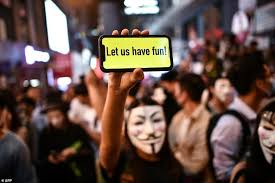 Below: terrifying halloween masks
Below: terrifying halloween masks 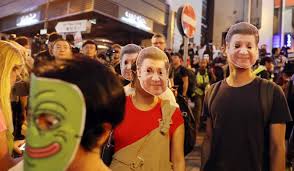
30/10/19:
Article showing how struggle breaks down false divide and rule
“…at a press conference held by anti-government protesters on Monday, themed “no racial division in the face of tyranny”….the group said they were hopeful for the future because they felt solidarity with mainstream society for the first time because of the sense of belonging offered by protesters.” Of course, there’s an ambigiuous expression here – “mainstream society”. Though it implies that the movement is now “mainstream”, it could also imply that “mainstream” is something to be valued in itself, and that any critiques within the movement of its limitations is unacceptable. Of course, this is stretching a point, but whilst everyone who wants a social revolution would like the most significant of their ideas to be taken up and acted on by movements, and so become “mainstream”, it also implies a certain desire for conformity that stifles real movement.
28/10/19:
Further clashes (videos and links)
Crackdown imminent
Two things about this:
Firstly, as Made in China Journal has said, “we should not hold our breath waiting for a single dramatic event or for the authorities in Beijing to formally announce the end of Hong Kong as we know it.” A crackdown can simply come from the cops raiding homes of known radicals and arresting them, taking their information from grasses, from slip-ups in not sufficiently securing messaging and from facial recognition cameras (FRCs) which are sometimes more sophisticated than they have been most publicly portrayed (ie some can more or less recognise faces through fairly flimsy masks like the surgical ones often used). And after arrests, show trials with draconian sentencing. Possibly less dramatic, and more “deomcratic”, than much of the repression – e.g. internment without even the pretense of a trial – used in Northern Ireland at the beginning of the 1970s and certainly no need for a Bloody Sunday (and remember – the Hong Kong cops are being helped by British state thugs).
Secondly, though Lam has denied that Beijing is planning to replace her, it’s obvious that once immediate “violence” (mainly against property and the state’s defenders of property) has been stemmed, she’ll be replaced so as to give the state an image of reform (see below). She can’t be replaced until then because that would be seen as too much of a concession to “violent” independent radical opposition. All of which means that a change of tactics and of perspectives needs to happen within the movement – wildcat strikes, occupations, anything that makes it harder for the state to divide and rule. And that requires ideas that go beyond the 5 demands.
Detailed suggestions for a recuperative reform, taking away from the super-rich, of Hong Kong’s economy so as to dangle the carrot of hope to the middle class or would-be middle class in the future, almost certainly in the wake of the coming dismissal of or resignation by Lam
“…economics is critical to any lasting peace. The essence of Hong Kong’s current economic policy, which is billed as a laissez-faire nirvana, is a regressivetax [1] in the form of high land prices. It strangles the middle class... prolonged slow growth exposes the corrosive effect the policy has on wealth equality [2] and labour income [3] . As young people’s aspirations are extinguished, a social explosion is inevitable.Chief Executive Carrie Lam Cheng Yuet-ngor’s policy address [4]… was very disappointing content-wise. A new initiative to allow homebuyers to borrow up to 90 per cent of the value of flats is sugar-coated poison. Under current circumstances, is a 10 per cent drop in property prices imaginable?If so, the loan-to-value ratio of 90 per cent seems like a trap for the middle class. It just allows property developers to unload flats at good prices in a depressed market. This continues Hong Kong’s policy bias towards the super rich, at the expense of the middle class.The Hong Kong government has long touted its tolerance of dubious business behaviour as laissez-faire economics [5] . At best, it is an excuse for laziness. At worst, it is collusion with tycoons [6] to squeeze every last drop out of ordinary people. The land shortage [7] could be seen as an intended outcome of this collusion. There are many other examples. The odds are good that Hong Kong’s laissez-faire economics is corruption in disguise. Supermarkets’ [8] high profit margins act as another regressive tax, which hits those in low-income brackets the hardest. Yet another egregious example is construction costs. Building costs [9] in Hong Kong are among the world’s highest, approaching New York levels, while those in Shenzhen are among the lowest. To make housing affordable, Hong Kong has to address both the issues of land supply and construction costs. …High land prices have raised much revenue for the Hong Kong government. While they are in fact indirect taxes, the government can claim they are business revenue that makes possible low direct taxes [10] , or none at all, for most people. The perception that little or no tax is being paid has given the government extraordinary freedom of expenditure, whether it is extraordinarily low welfare subsidies for the poor or generous compensation for government employees [11] . The Hong Kong dollar’s peg to the US dollar has deepened the flaws in the system. The US Federal Reserve has been pursuing an expansionary monetary policy over much of the past three decades. Hong Kong is effectively importing super-low interest rates via the currency peg [12] . It covers up the burden of housing debt and allows developers to constantly push up prices, while exposing Hong Kong’s labour force to unchecked international competition. Hong Kong’s currency peg is a key factor in the unfairness of its economic structure. It should be abandoned at an opportune time. To overcome the land crunch, Hong Kong must remove the incentive to hoard land [13] ….A remedy would be to introduce a high land appreciation tax; 60 per cent is a good number to start with. The tax should be assessed and collected annually. When such a tax is introduced, the government would suddenly find zero resistance to its initiative to increase land supply. As the government stops relying on high land prices for revenue, it should start collecting progressive taxes on property and income, just like in a normal economy. For example, the tax rate could be zero on properties under HK$5 million, 1 per cent on those between HK$5 million and HK$10 million, 2 per cent on those between HK$10 million and HK$20 million, and 3 per cent on more expensive properties. In addition to the standard income-tax rate of 15 per cent, there could be a tax rate of 25 per cent on incomes above HK$5 million. To close loopholes, business income should be taxed at the same rates.If the violence continues in Hong Kong, the only winner is Beijing [14] …The government must take concrete measures to boost housing supply immediately. …Hong Kong should keep increasing housing supply until prices fall to within a reasonable range of around one month’s salary for one square metre. …The necessary restructuring of Hong Kong’s economy would inevitably hurt some interest groups. Big businesses would obviously lose their huge profit margins and become like their counterparts elsewhere. Clearly, they could be expected to fight to keep their privileges. As they have good access to Beijing, meaningful economic reform is unlikely to happen without political determination at the top…Hong Kong must accept some pain to enjoy a rebirth. Otherwise, today’s youth have no hope of owning a home fit for raising a family. How, then, will stability return to society?”
27/10/19:
More clashes…more here and here
“…protesters set fire to shops in Jordan and hurled petrol bombs at Sham Shui Po Police Station, blocking roads and assaulting officers with hard objects and umbrellas…Riot police and protesters also clashed in Whampoa, Yau Ma Tei and Mong Kok, where tear gas was fired.”
Proof that “the economy is the secret p0lice of your sense(s)” …large drop in profits
“Tourists numbers have plummeted, a decline Chan called an “emergency” with the drop in visitor numbers worsening in October, down nearly 50%.”
“Tourism — human circulation packaged for consumption, a by-product of the circulation of commodities — is the opportunity to go and see what has been banalized. The economic organization of travel to different places already guarantees their equivalence. The modernization that has eliminated the time involved in travel has simultaneously eliminated any real space from it.” – here. Anybody with a sense of life would be interested in going to Hong Kong now, now that the area has lost its equivalence to other places, now that history is returning there in a unique way and that opposition to the economy, even if not intentional, makes the secret police that the economy fundamentally is not so secret after all. Whilst we’re a long way from from an explicit opposition to the commodity economy, from such a revolutionary aim, it’s clear that despite this absence, the effect of this movement subverts this economy.
25/10/19:
Long excerpt from “Made In China Journal”:
Some people suspect that the Central Government in Beijing aims to draw on the methods utilised in Xinjiang to implement heavy-handed rule in Hong Kong, such as by running relentless campaigns against local culture and forcibly assimilating people through CCP thoughtwork. However, such a scenario is highly unlikely considering that the cost of such Orwellian rule is extremely high. Moreover, due to Hong Kong’s cosmopolitan status, applying this kind of model to the city would surely invite violent opposition both locally and internationally. Another more viable strategy is to learn from the governance model adopted in other cities in mainland China, where the Public Security Bureau (公安) and the Urban Management Bureau (城管) cooperate closely and utilise high-tech surveillance systems to ‘maintain stability’ (维稳). Once this governance model is replicated in Hong Kong, assisted by technologies such as those underpinning the emerging social credit system, the CCP will be in a position to systematically and thoroughly keep any dissident voice under surveillance. To effectively implement this strategy, the CCP would not only require support from local gangs and the middle- and upper-classes of the city, but would also need to domesticate local civil society and academia.
The core groups in the recent anti-government movements are mainly composed of NGO members with varying amounts of influence in Hong Kong’s civil society. Hong Kongese civil society has developed a high-level of autonomy from the government since the social movements of the 1960s, and some professional sectors, such as social workers, have maintained a strong tradition of critical thinking and civic engagement. As a result, if the CCP attempts to assert control over Hong Kong’s social workers and NGOs with the same strategy used in mainland China—by requiring ‘Party-building’ in social work organisations and changing them into ‘Party service centres’—strong opposition from Hong Kong civil society is to be expected.
However, in dealing with local NGOs, the CCP can take advantage of different types of ‘centralised systems’ that have been well-developed in Hong Kong since colonial times. Very often, Hong Kong has been seen as a textbook example of a ‘free market’ society. However, in many aspects, especially in social and welfare services, the Hong Kong government intervenes heavily. Through these service interventions, the government centralises and allocates resources. Today, nearly half of Hong Kong’s population lives in houses subsidised by the government; nearly 90 percent of the hospital beds are publicly funded; most established and large NGOs in Hong Kong receive ‘lump sum grants’ annually from the government for recruiting social workers and supporting their service programmes. In the education sector, all public universities in Hong Kong receive sizable block grants and research grants to support their teaching and research programmes. These centralised systems for the allocation of resources have far-reaching implications for Hong Kong’s civil society. For instance, although Hong Kong’s civil society is generally seen as vibrant and independent, under this centralised system many small- and medium-sized NGOs active in supporting pro-democracy and human rights movements do not receive much funding from the government. This results in Hong Kong having an active but structurally weak civil society.
Although ‘Party-building’ in Hong Kong’s NGOs is not realistic in the short term, Beijing can still work through these centralised systems to achieve a similar effect. By marginalising ‘dissident groups’ via the government funding allocation system and simultaneously ‘incubating’ pro-Beijing organisations, the CCP can fundamentally transform the composition of Hong Kong civil society, making it more pliable to its demands.
Academia is likely to become another target. Since the Umbrella Movement in 2014, the CCP has been treating the higher education sector as a seedbed of anti-government movements, which are accused of colluding with ‘hostile foreign forces’. Scholars active in social movements are thorns in the side of the pro-Beijing camp. Apart from jailing Hong Kong scholars and students on trumped-up charges, the CCP will probably exploit the mechanism through which the government of Hong Kong allocates budget and research funding to public and private universities. Consequently, courses and research programmes on undesired topics—such as social movements in Hong Kong, approval ratings of Hong Kong government officials, and ‘stability maintenance’ in China—will be marginalised or shuttered. If this occurs, research proposals and course materials will end up having to be approved by the Party branch at universities, just like is happening in mainland China.
In fact, ‘China’ is a hot topic among Hong Kong scholars and there already are different forms of research and teaching cooperation between universities in Hong Kong and the mainland. Today, when Hong Kong scholars want to conduct research in the mainland, they have to ‘settle’ in partner universities in the mainland. Research proposals and details are subjected to approval by the Party branch at the host university, which makes conducting critical research on sensitive topics almost impossible. As a result, the Hong Kong system is already being assimilated gradually into the China system.
In the end, we should not hold our breath waiting for a single dramatic event or for the authorities in Beijing to formally announce the end of Hong Kong as we know it. Hong Kong’s assimilation into the mainland governance regime will most likely be accomplished subtly and through systems and infrastructures that are already well developed. As such, opposing Beijing’s growing influence in Hong Kong is not enough. It is also necessary to critically examine the structure of governance in the city and to identify the existing structures that are facilitating Hong Kong’s ongoing transformation.
Ban on doxxing of cops could lead to ban on any anti-cop expression
“The ban on publication of photos of police officers without their permission could mean media could come under pressure over their reports… The Justice Department sought the injunction to target protesters or people who “doxx” police officers by releasing their details online. The order also bans “harassing, threatening, pestering or interfering” any police officer or family member…. a person who is having a financial dispute with the spouse of an officer and calling the person repeatedly over this could now be seen as a contempt of court. Sharron Fast, a media law expert at the University of Hong Kong, echoed Wong’s opinion that the injunction banned activity “far beyond doxxing”. “It would certainly capture the chants and name-calling that the police have long wanted to have legislative protection from,” she said….”[It’s a] serious restriction on freedom of expression and effectively criminalises a whole range of perfectly lawful acts which will now be punishable as contempt of court,” he tweeted.”
Blue dye in water cannon possibly toxic
Mind you, in France the state uses water cannon laced with teargas.
24/10/19:
Pro-Beijing fuckers attack restaurant giving out free food to protesters
23/10/19:
Report on tagging of university lecturer’s door after he threatens anybody who brings up political questions in class
“For any future presentations in class, if you use it as an opportunity to broadcast any political announcements or statements, the whole group will automatically get zero points for the presentation,” he wrote on Friday. CityU students responded by spraying derogatory graffiti on the front of his office, including the words “white terror” and “Hongkongers rebel”…One wrote: “You are here to teach. Do not bring your political agenda into assessment criteria.”
22/10/19:
State tries to boost the ‘the economy’ as retail sales and tourism drops
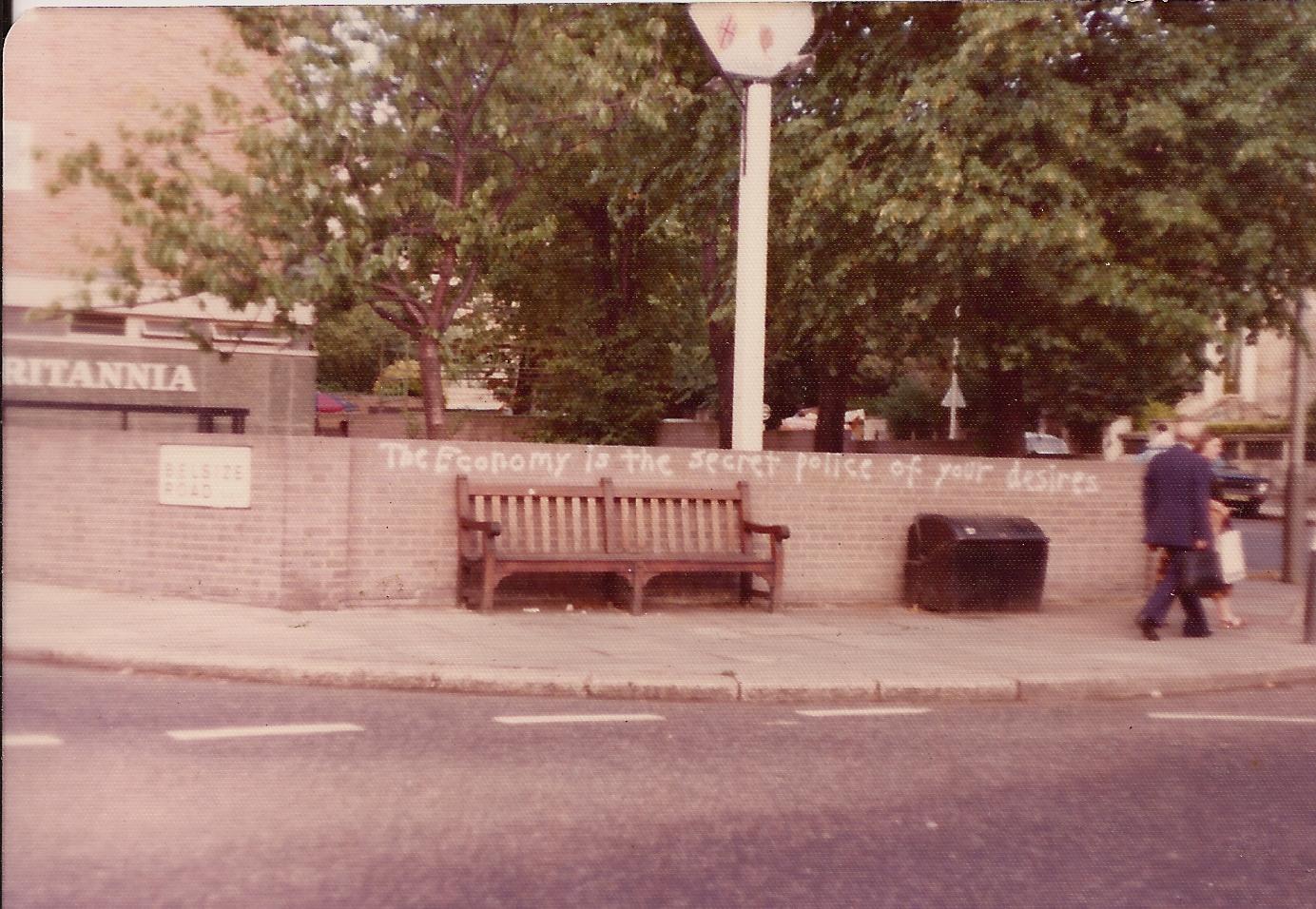
20/10/19:
Massive attacks on mainland-owned businesses, roads blocked, etc.
“The arson attacks began from around 3pm and lasted for more than eight hours as protesters set fires inside mainland-linked businesses and police and metro stations, before gutting a Xiaomi shop and Chinese medicine store Tong Ren Tang in Mong Kok…Protesters cut down a surveillance camera near a Yau Ma Tei MTR exit with an electric chainsaw, before setting it on fire. They then threw petrol bombs inside at least four metro stations through their closed exits – forcing the partial suspension of the Tsuen Wan line and the closure of at least 14 stations…a bomb disposal robot – believed to have been deployed for the first time during the four-month protests – had also detonated a suspected explosive device inside a cardboard box placed at the intersection of Lai Chi Kok Road and Tong Mi Road in Tai Kok Tsui.Protesters also set a traffic light controller ablaze“
Unfortunately the sick anti-looting ideology of the protesters lead to the tying up by protesters of an elderly man who’d nicked at least 3 mobile phones from a trashed store. Clearly they’d find what’s going on in Chile incomprehensible. Also noteworthy was the spraying of blue dye of a mosque by the cops for no reason whatsoever (See this). Plus, of course, the above mentioned bomb disposal robot, possibly a psychological preparation for some future genuine bomb, possibly planted by a section of the state.
18/10/19:
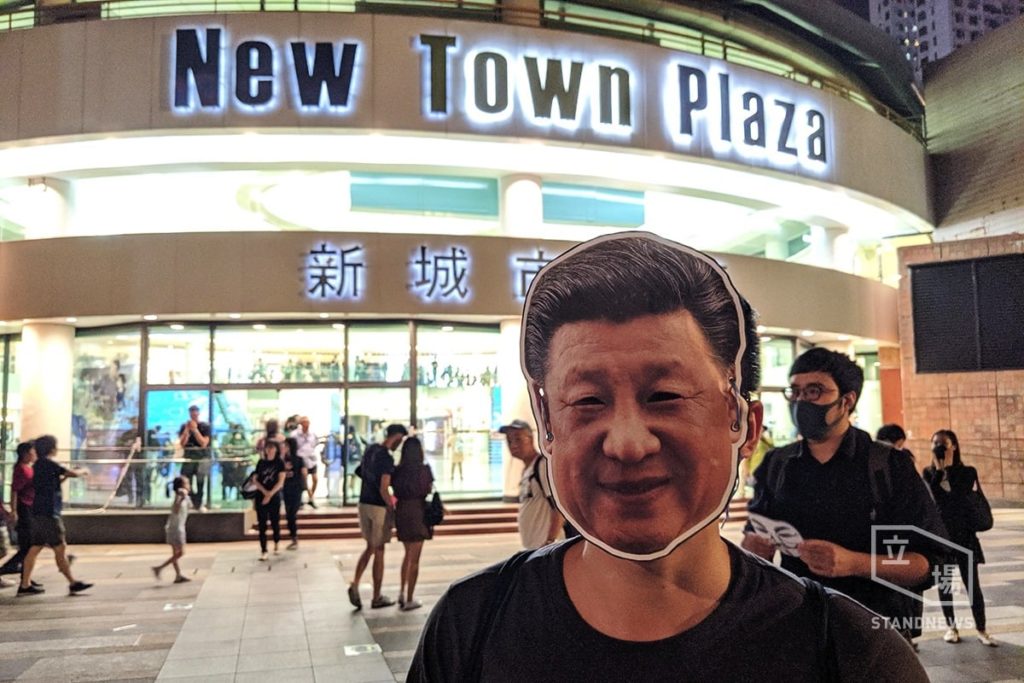 “Xi who must be obeyed” seen at demo
“Xi who must be obeyed” seen at demo
17/10/19 :
“People should not be afraid of their governments – governments should be afraid of their people”
This is a quote from the link to a moving video about young protesters ready to die. Though some of this sounds a bit like martyr-wish syndrome, it’s not as simple as that. Obviously anybody who is serious about striving for a revolution knows that being killed is a risk you take, though, without compromising fundamentals, it’s a risk that precautions should be taken against. This borders on this basic realism and a sacrificial mentality.
More on explosives find (see entry for 14/10)
Red Guards show how they’re Blackguards
16/10/19 :
Almost 70% wish to disband police force (in Mandarin)
Another indication that Lam may well get kicked out
‘‘…pro-Beijing lawmakers criticised the policy address for not taking decisive steps to quell the ongoing protest movement: “Our view is that the policy address follows a well-worn path and is powerless in breaking the deadlock,” said DAB party leader Starry Lee. “Facing the chaos in society today, the public hopes to hear from [Lam on] how to bring things back to normal.” The public does not feel that Lam can solve the deep-rooted issues facing Hong Kong, and the policy address did not offer concrete proposals to change that perception’’
Reactions to the speech from the business sector of HK were supportive because she addressed the housing issue, which, despite the official opposition’s dismissal of it, could hold out the carrot to some of HK’s population as a compensation for withdrawing from invovlement in the struggle, a clever bit of recuperative reform that I’ve mentioned previously as a possibility, but now seems very likely to go ahead.
See also: Further evidence that the Hong Kong ruling class may get rid of Lam? Or just an opportunist attempt at popularity by opposition legislators?
14/10/19:
Students vandalise CCTV camera and glass doors after suspicious death of 15-year-old protester and suspicious CCTV footage of her More here.
Was this a bomb planted by the state or was it made by protesters ?
Who knows ? It’s certainly possible that the state is preparing the ground for a bigger bomb which would maybe seem to target cops but in fact kills loads of other people (see what I’ve written far too often before – in particular what I wrote on 11/9/19, though hopefully this is me crying wolf yet again), or some variant on this – eg one that does kill loads of cops, with all its obvious consequences and probably some not-so-obvious ones. It could also have been a bomb made by a protester with no sense of strategy. Who knows ? But speculation is potentially also preparation for such a possible event…
Possible freeze of the minimum wage
‘‘The government-appointed Minimum Wage Commission has refused to rule out the possibility of freezing it in future, citing the economic risk from the ongoing anti-government protests and the US-China trade war. Priscilla Wong Pui-sze, the chairwoman of the commission, said on Tuesday that any future adjustments would have to be based on “objective data and figures”. She also refused to commit to reviewing it on an annual basis, rather than the current two years, saying the commission was still assessing the impact of the latest increase in the minimum wage, which rose from HK$34.50 to HK$37.50 on May 1. Next year the commission is due to submit suggestions to the government on what the new minimum wage level should be in 2021. But commission representatives from both the labour and business sectors said that although no official data was available, the impact from the citywide protests that started in June was already being felt, with workers in the tourism and hotel industries being placed on unpaid leave….’’. Regardless of whether this comes from a purely (bourgeois) economic assessment of ‘‘affordability’’ or a conscious attempt to turn workers against the movement, this should/could provide an incentive for protesters to work out ways to connect this movement with other sections of the working class (not that most protesters aren’t part of the working class, but that their protest is outside of their work concerns and doesn’t express itself in class terms).
13/10/19:
Nice short video
Hong Kong cop violence – made in the UK
Very interesting report, which I’ve just received from a friend. Shows not only how the UK cops directly help the HK filth in their tactics against HK protesters, but also how the experience of HK cops in 1967 helped cops at Orgreave against the miners in 1984 and elsewhere in the UK.
Change of tactics
More here. A professional defender of capitalist violence gets slashed in the neck with a box cutter, and other stuff.
12/10/19:
Government office and tube station torched during further protest
“…police fired a shot outside the Mong Kok police station. The shot, possibly a rubber bullet or sponge round, was fired after a small group of protesters shouted obscenities and shone laser at police officers, who rushed out to subdue and beat a couple of young men…Many protesters wore medical masks on Saturday but a few also wore balaclavas…Onlookers jeered and yelled obscenities at officers who wore black face masks and obscured their police numbers. The atmosphere became tense when an officer rushed up to a young couple who wore medical masks but were not part of the protest. “Take off your bloody masks. Show your identity cards,” he shouted. Another officer said: “See a doctor if you’re ill.” Passersby shouted back at police. One young father, holding his infant daughter, told them: “Beware of what sort of a world you’re creating for your own children.” Several police officers rushed up to intimidate him. His wife said through tears: “We’re protesting today precisely because we have a child. If we don’t speak up for others now, who will speak up for us?” …A police officer shouted at and pointed a metal stick at the face of an elderly woman who was trying to mediate between him and an angry protester, leaving her trembling. Meanwhile, marchers vandalised two government offices and a coffee shop seen as being pro-Beijing, and a petrol bomb was thrown at the gate of a metro station not on the route of the protest. No one was hurt in the incident. Protesters smashed glass and sprayed graffiti on the walls of the Kowloon and Cheung Sha Wan government offices. Police said the demonstrators also broke the gate, entered the buildings and started a fire.”
More here “…A small group calling itself the “Silver-Haired Marchers” began a 48-hour sit-in at police headquarters on Saturday, describing themselves as “old but not obsolete”. “The young people have already sacrificed a lot, it is about time for us, the senior citizens in Hong Kong to come forward to take up part of the responsibility from the young people,” 63-year-old Shiu told local media. “I mean for us, even if we are caught by the police because of an illegal gathering, I don’t mind,” said Shiu, who was identified with only one name. Police have arrested more than 2,300 people since June. Since September nearly 40% were under the age of 18 and 10% under 15….Protesters have also targeted China banks and shops with perceived links to China, as well as U.S. coffee chain Starbucks, which had a store in Kowloon trashed on Saturday.“
It’s easy to see limitations from a distance and for this reason maybe it’s presumptuous of me to make the following reflections. However, it seems that this movement could well slow down through the repetition of the same tactics and ideas. New tactics (such as occupations and more extensive strikes) and the development of some more subversive ideas are essential to keep the momentum going and to make some qualitative leaps. Attempting to influence the mainland again – as happened on the 8th July, when protesters used the AirDrop app to breach China’s Great Firewall – if that particular breach hasn’t been dammed up since then – would also be an excellent development.
10% of ATM’s throughout territory made unoperational
Hong Kongers begin to realise, at long last, that Trump is as loyal to them as he is to the Syrian Kurds
“Trump said the trade deal he struck with China on Friday was “very positive” for Hong Kong and claimed the anti-government protests had de-escalated significantly, leaving some demonstrators disappointed he did not push for their cause. …“Trump thinks we should pack it in. We still want to count on the Americans?” A user wrote and won over 1,000 likes in three hours. Another user said: “I have said western countries would only view Hong Kong as their pawn. Don’t be so naive that they value the so-called ‘values of democracy and freedoms’.” The comment won over 160 likes in 3 hours. While some urged others to be “awake” and just count on themselves and Hongkongers, several others suggested the “escalation of force”. Yet another group of users believed they should work harder to explain to the world the reasons behind the drop of participants and organise another massive peaceful rally.” Sadly, as far as I can see, nobody suggested that the struggle is international – that they should connect to movements in Ecuador, Haiti, Indonesia, etc., even if the specificities of capitalism in each country are different.
11/10/19:
Report on triads and other gangs support for the state (and the state’s support for the triads)
“Hong Kong’s police, he and other officials claim, are behaving like “servants” of crime syndicates loyal to Beijing — and thus “forcing people to defend themselves.” …Since the 1980s, Hong Kong’s cops have been revered by its citizens and envied across much of Asia. They are the rare department that managed to purge the shakedowns and gangsterism that still plague police units throughout the region. Yet, Lam contends that police are now “colluding” with organized crime — or “at least turning a blind eye” when thugs mete out raw violence toward protesters.”…Why would Hong Kong’s mafioso take time away from extorting shopkeepers and dealing heroin to beat down protesters? But beneath Hong Kong’s surface are complex power dynamics — a world where gangsters can be pro-China patriots and, for crime bosses, terrorizing a protest might actually be a smart investment.”
9/10/19:
Report on undercover medics helping people fearing arrest if they go to government hospitals
7/10/19:
Days events (includes 6/10) – videos and links
China state media urges quicker trials and heavy sentences for Hong Kong protesters
Report on the spread of solidarity and the kindness of strangers Report about October 1st on how whole neighbourhood helped protesters escape cops and teargas, inviting them into their flats, providing reconnaissance information about cop movements etc. “So even those not protesting on the streets are protesting, all contributing to the resistance in their own way. The majority of the city is united against the regime. The story of Wan Chai is not new to me: I’ve experienced the kindness and aid of strangers many times in recent weeks. Just days before, I’d been going toward Causeway Bay together with about 2,000 protesters, again retreating from the police. We heard there were a lot of riot police in Causeway Bay and so decided to head southward, but every street we came to, we saw police at the end of it. Eventually, we had no choice but to go into Happy Valley, a prosperous neighbourhood that has seen little of the protests. It was terra incognita for most of us. Once there, we felt safer, but we knew it was just a matter of time before the police would try to flush us out, and we didn’t know where to go. Security guards emerged from middle-class high-rises and offered directions. A taxi driver had seen us and alerted his colleagues. Before long, dozens of taxis started to arrive. Private drivers pulled up, rolled down their windows, and announced their destination. Protesters hopped in. Within about a half hour, of those 2,000 protesters, no one but myself and a few others remained on the street. Among protesters, a guardian rule is you never leave anyone behind. I play the role of the one who remains until last to make sure everyone gets out. I changed out of my outfit and headed back to cross police lines. Along the way, knowing residents who witnessed and helped the evacuation gave me knowing smiles and thumbs up. “Stay safe, stay safe,” they said….This kind of resistance – it’s a feeling within us. Hong Kong people are famously phlegmatic, unexpressive. We don’t talk much or effuse. But these days, we recognise something in each other, a common purpose, a common identity. This is the sort of unity that can’t be crushed by force. In fact, police attacks fortify it, drawing us closer together. I’m often asked how this will all end. My true feeling is, it doesn’t matter, because the little secret that everyone knows and no one is saying (and perhaps many aren’t even admitting to ourselves) is, we’ve already won. The immediate and original concrete objective, the withdrawal of the extradition bill, has been achieved. We’ve won the battle for hearts and minds. But beyond that, we’ve achieved something much more profound than that: confidence in ourselves as a people and trust in one another for what is sure to be a long, hard struggle ahead.”
On fires and firebombs The fact that such an apparently ‘neutral’ source of information as the fire brigade could warn of potentially frightening consequences of firebombs got me thinking that instead of an obvious terrorist attack (like the fascists’ Piazza Fontana bombing following the Italian autumn movement of 1969 – see also this), the state might try to arrange a fire that kills loads of people. They did this in Athens in May 2010, when young nihilist anarchists firebombed a bank. It was a strike day, and the young guys thought the bank was empty (the doors were locked). In fact, the management had locked employees in – and 3 were killed. There was no fire exit, no sprinklers or fire extinguishing apparatus in the bank (see this and the following posts for details…eventually 3 bank officials were found guilty, though the head of the bank – Andreas Vgenopoulos – the main person responsible – got off scott-free, surprise surprise). I’ve cried wolf so many times over the possibility of a state (or maybe triad) strategy like the Piazza Fontana bombing in ’69, maybe nobody will believe me, but it seems like a real possibility but maybe taking another form like a fire.
6/10/19:
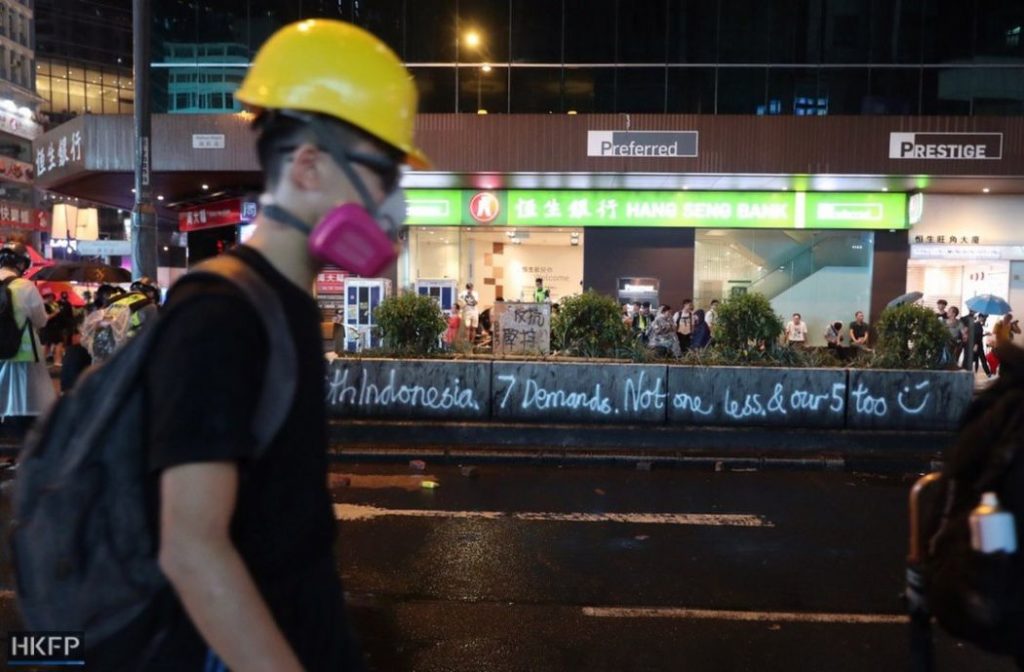
Fury across the island “ For the first time in the crisis, men on the roof of one of the Chinese military’s barracks in Hong Kong raised a yellow banner warning protesters they were breaking the law when laser pointers were flashed at the building, according to video broadcast by Hong Kong media….” They can’t arrest us all. There are thousands of us…There is no going back — we are at the point of no return.” … Groups of black-clad youths roamed the city center, setting up barricades, covering the urban landscape with anti-China graffiti, cutting power lines to traffic lights and using walkie-talkies and messaging apps to coordinate.”
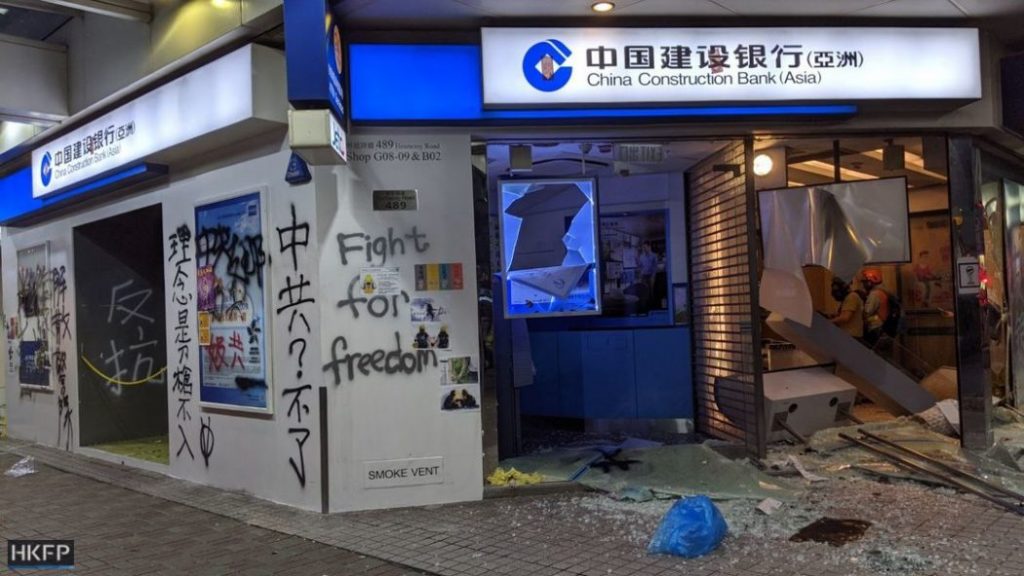
Sadly, it’s only mainland banks that are targeted. Although a lot of mainland Chinese-owned shops and businesses have been targeted, no looting to speak of has taken place. On the contrary, there’s been a lot of discussion on the internet expressly prohibiting it. In fact, when some middle-aged women went into a Bestmart 360 to take something for themselves recently, they were publicly condemned, without the slightest proof, as being cheap mainlanders who were probably against the movement, but were ready to profit from the disorder if they could. A truly sad indication of how limited to purely political concerns most of the discussion round the movement is, and how shallow stereotyping of anybody who doesn’t conform to the democratic discourse is necessary to tightly constrain this discourse. In order to maintain the ideology of “unity” which prevents anybody discussing differences within the movement, those who don’t conform to the parameters of this political discourse have to be seen to be outside this movement in order for this ideology to be set aside.
In another context, me and a friend wrote: “…the ideology of unity is mainly used … to say “Shut up” to discordant and minority voices. “Unity”, justified by the argument that one must not …be a minority, serves above all to get as many people as possible caught up in the dominant logic… against all aspects of the autonomy of those who revolt. It prevents any discussion, any possibility for individuals to exchange opinions and to go beyond their limits, their illusions, by giving them the false feeling of being part of something… It is only with debate and criticism that those who revolt – proletarians – can glimpse new possibilities, conceive of the project to get rid of this society, and start working on it.” – here
.

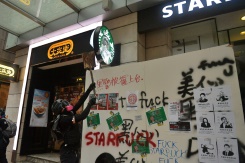
Rich film star who’d (in July) called the protesters “rubbish” attacked
Instead of making out she’d physically attacked them first (which she hadn’t), it’s a pity these protesters didn’t affirm that they were perfectly right to attack her for defending the filth and the state. People like her live such cocooned lives that they don’t get anything and think they can arrogantly trash youths desperately worried about their future without suffering the consequences.
5/10/19:
Will Lam get the sack in order to give the appearance of change and reform? This article suggests she should be replaced by Matthew Cheung, a somewhat reticent poolitician whose only notable statement was in response to a high school students’ strike – “Schools are places for learning, and are absolutely not places for expressing political views or demands.” But as some high school students in Soweto said in 1976 “The school for the oppressed is a revolution”. The article also says that any new leader “should find a new voice and immediately announce a wholly transparent and independent inquiry into the anti-extradition debacle that includes an investigation into allegations of police brutality. And the police need to take this bitter bill and swallow it whole for the good of the city.”, an option which, from this distance, seems a genuine possibility and more likely than a Tiananmen-type massacre. Of course, “a wholly transparent and independent inquiry…that includes an investigation into allegations of police brutality ” is likely to be the way that they’ll dress it up rather than be genuinely “transparent and independent”. Given that Hong Kongers have some – to be polite – “naive” illusions in the UK, we can expect the kind of “transparent and independent” enquiries that go on there, “transparent and independent” enquiries which have never ever once found a single cop guilty of any one of the innumerable deaths at their hands.
State demands a return to its monopoly of violence as tourist gets his priorities right – the despair caused by his inability to get to Disneyland “Can’t go anywhere,” said Kevin Cui, a tourist from mainland China who’d planned to visit Disneyland only to discover at a shuttered subway station in central Hong Kong that the network was suspended. “This is very troublesome.” …After widespread arson attacks, looting, fighting with police and beatings, the government appealed for a public shift in attitude against rioting. John Lee, the government’s security secretary, said by not condemning violence, people are stoking it. “What is adding oil to violence is people’s support for these acts,” he said.“
2nd teenager shot by live round as fury erupts against face mask law “The city’s major transport network MTR suspended all of its operations after demonstrators vandalized multiple train stations, setting fire to entrances and smashing ticketing facilities. Numerous mainland Chinese-owned banks and stores were also targeted by protesters. All of the city’s 161 MTR stations remain closed Saturday, as do many major shopping malls, bank branches and supermarket chains. Many of the grocery stores and banking facilities that are open have long lines reminiscent of the run-up to typhoons, as Hong Kongers withdraw cash and stock up on supplies. Violent protests which began Friday stretched into the early hours of Saturday, beyond the midnight deadline when the new anti-mask regulations began. They spread out across the city and soon devolved into violent clashes, with protesters throwing petrol bombs and police responding with pepper spray and tear gas. A second protester was shot with a firearm in an incident in Yuen Long — the site of an attack on protesters by alleged triad gangsters in July which has become a key rallying cry for the anti-government movement. Police said a 14-year-old boy was injured in a shooting incident after a lone plain clothed officer was attacked by protesters. Hospital authorities said the boy was shot in the left thigh and is in a “critical condition…police said after the police officer was isolated by protesters, he “fell onto the ground and was beaten up by the group. Facing serious threat to his life, he fired one shot in self-defense. A rioter then threw a petrol bomb at him and his body was on fire.” A video circulating online showed the officer, wearing a white t-shirt, getting up from the floor when a petrol bomb hits him and engulfs him in flames. The officer staggers forward and manages to extinguish the fire on his clothes, but appears severely dazed. He drops his weapon and it is almost grabbed by a protester before he lunges forward and manages to wrestle it away from them”
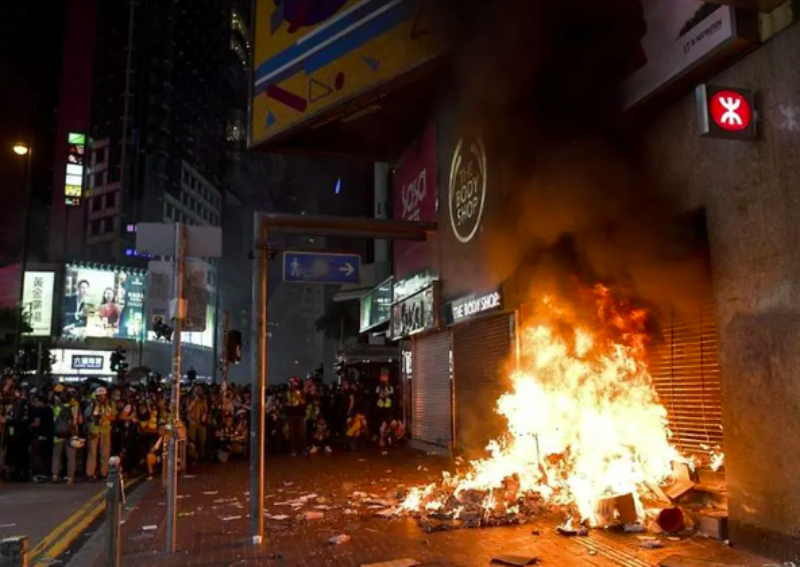
4/10/19:
Pro-Beijing Trade Union bureaucracy that participates in Legislative Council complains about being attacked “The Hong Kong Federation of Trade Unions, Hong Kong’s largest labor organization, said its many service centers were attacked by rioters, who scrawled the walls, smashed the gates and broke window glasses. The HKFTU said some centers sustained damage so severe that their service might be suspended for days…Noting that the violence only made it firmer in its patriotic resolution, it urged the HKSAR government to come up with effective measures to combat violence and the police to bring rioters to justice.” The HKFTU “…is a pro-Beijing labour and political group established in 1948 in Hong Kong. It is the largest labour group in Hong Kong with over 410,000 members in 251 affiliates and associated trade unions. Presided by Ng Chau-pei and chaired by Wong Kwok, it currently commands five seats in the Legislative Council of Hong Kong and 30 District Councillors. Being one of the oldest existing labour unions in Hong Kong, the HKFTU has a long tradition of following the command of the Communist Party of China… In the 1980s, the HKFTU took the vanguard role in opposing faster democratisation in Hong Kong… It allied with the Hong Kong government on many issues…Due to its government loyalist nature, industrial militancy has been remarkably absent from the HKFTU’s action programme” – Wikipedia. Re. the president, Ng Chau-Pei – he is even more anti-democratic than Lam, having slammed the Appeals Court decision in September 2018 to free the group of 13 activists, who had each received jail sentences of up to 13 months from a lower court for unlawful assembly outside the Legislative Council on 13 June 2014, calling the judges “sinners of society”, comments which Lam said were “unacceptable”.
JPMorgan banker beaten by anti mask law protester
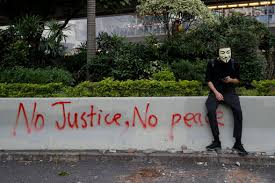
1000s wear masks in protest against impending anti-mask law “Large crowds of mostly office workers hit the streets during the workday lunch break over the pro-Beijing regime’s expected use of colonial-era laws that opponents said would tip the city towards authoritarianism… “Youngsters are risking their lives, they don’t mind being jailed for ten years, so wearing masks is not a problem,” a 34-year-old office worker wearing a surgical mask, who gave her first name as Mary, told AFP at a protest on Friday afternoon… the city’s subway system said 83 of its 91 underground stations had been vandalised in recent months after protesters turned on the operator because it began shutting down parts of the network ahead of large protests…Pro-establishment lawmakers and a prominent police officer association have ramped up their calls for the government to invoke the emergency laws, which were last used 52 years ago by the British during deadly leftist riots.” Video “Protests in at least 14 neighbourhoods…” …Lam suggests more to come, such as curfews
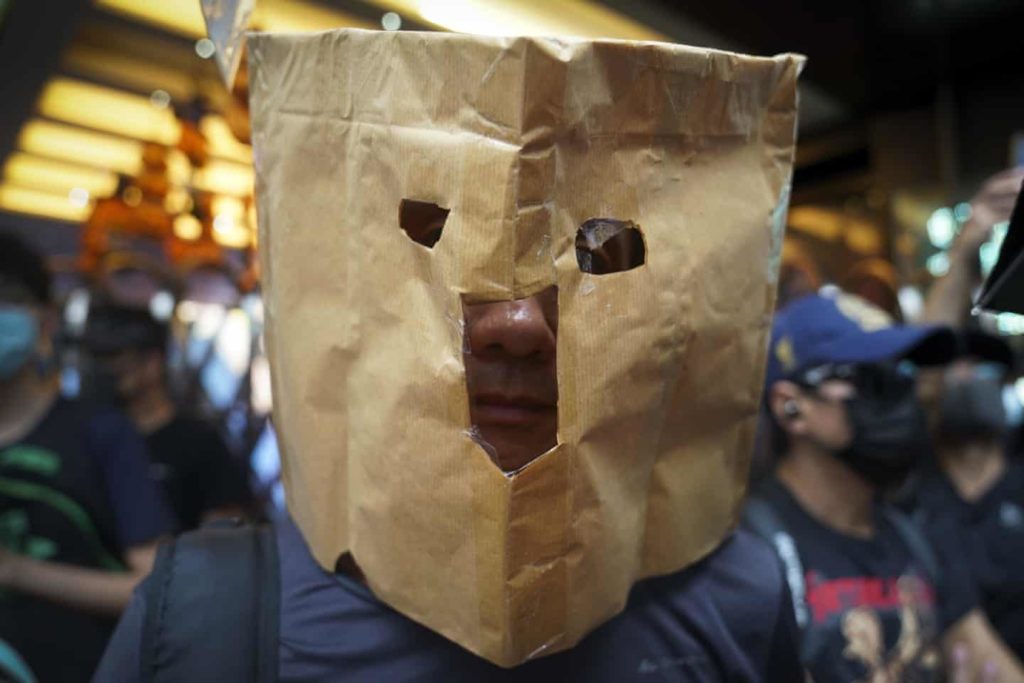
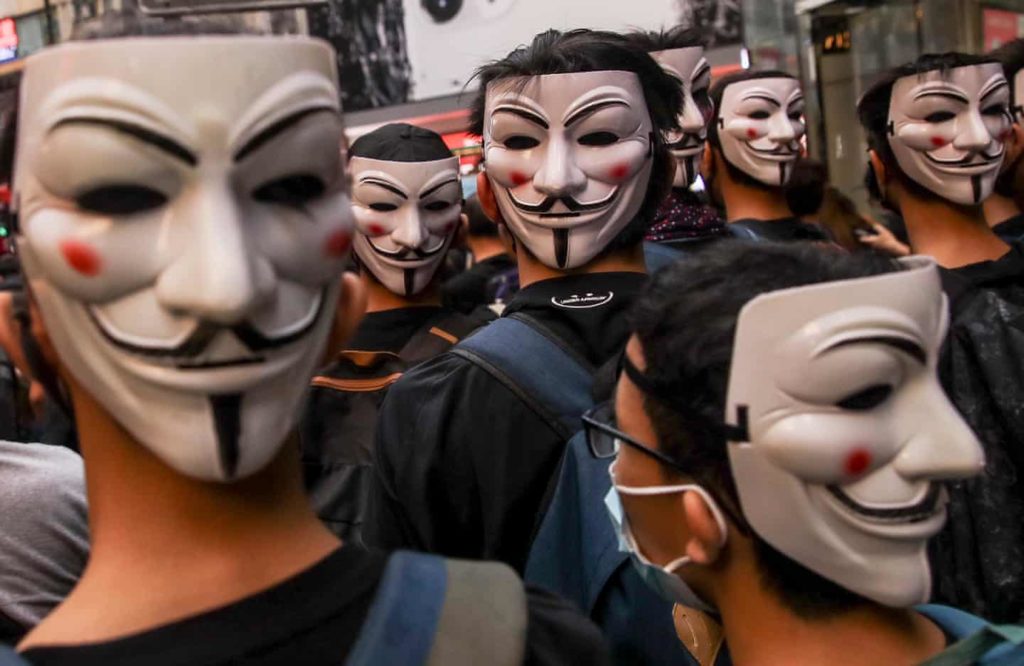
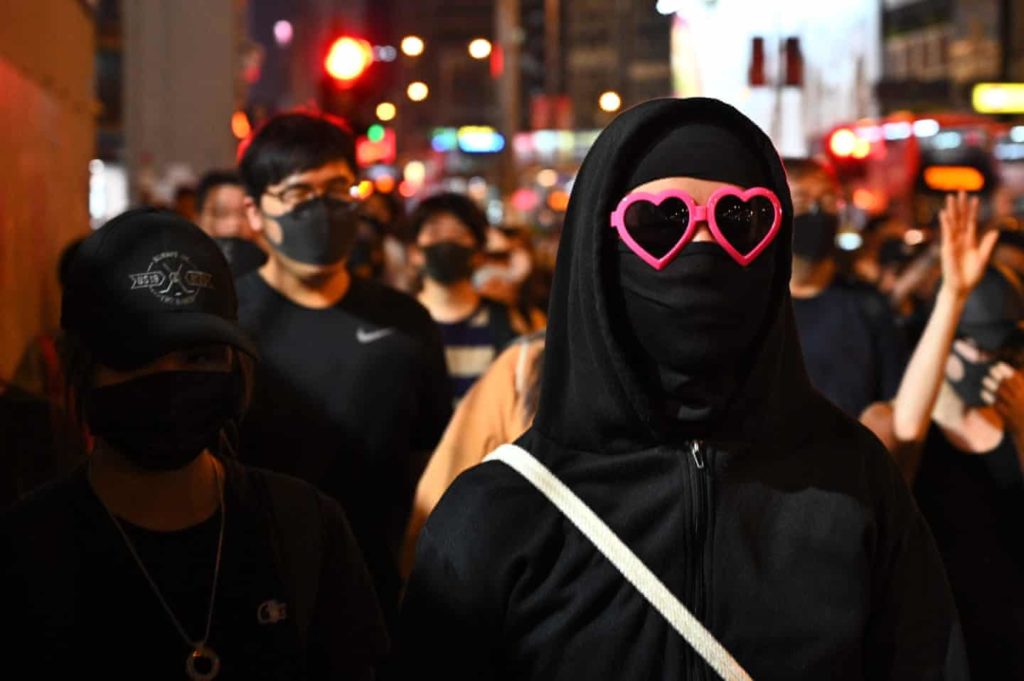

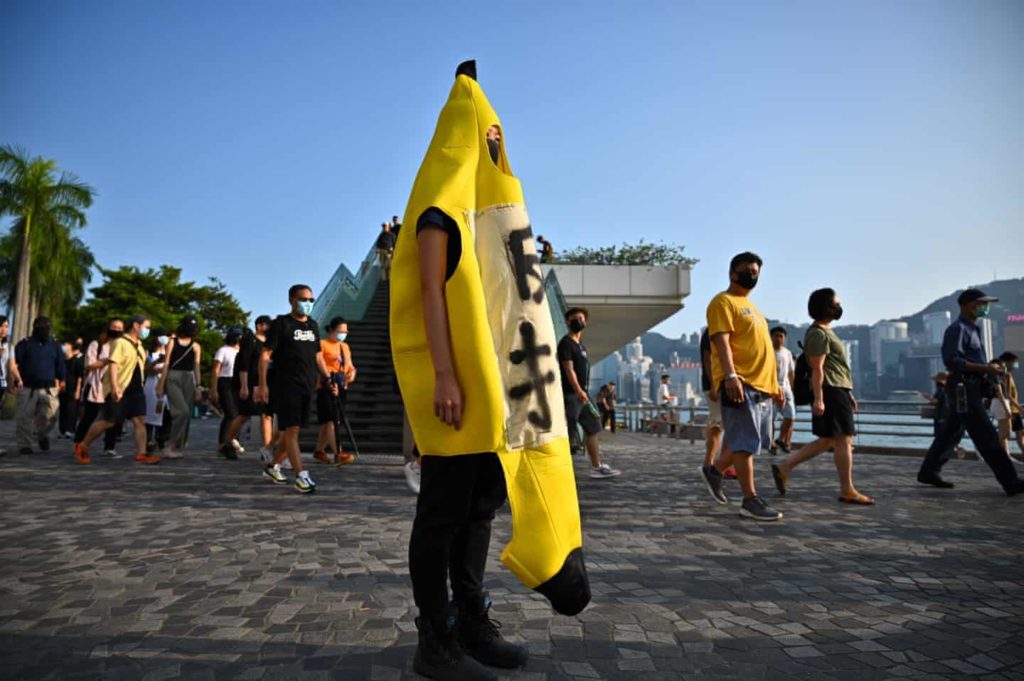
Nobody with a position in the social hierarchy has suggested that people remove the masks imposed by the system they profit from which are needed to hide their inner doubts, dreams and individuality, needed to repress anger and desire, masks that everyone is forced to put on in order to sell their labour and not get sent to an asylum, prison, or Coventry, masks that keep us separate, masks that above all “protect” us against the anxiety of genuine communication whilst also avoiding recognising the absence of genuine communication. There’s an irony in the fact that those people who are forced to wear masks to avoid arrest are beginning to overcome these socially-required masks conditioned by the permanent pressure of the system: “Hong Kong people are famously phlegmatic, unexpressive. We don’t talk much or effuse. But these days, we recognise something in each other, a common purpose, a common identity.” – here
3/10/19:
Face masks to be banned …clashes begin in response to this proposal… Hong Kong police and legal experts say it’d be hard to enforce in streets and courtrooms “A police chief inspector who has been at the front lines of the protest crisis since June, said a ban on protesters wearing masks would “unnecessarily stir up more trouble”. “Right now, only when we arrest protesters will they remove, or be forced to remove, their masks,” said the inspector who requested anonymity. “But if the law is passed, a protester wearing a mask will be seen as provoking the police and asking for trouble. This will definitely cause more conflict.” Another inspector said protesters would strive to find exemptions from the ban. “What if the guy says he wears a mask because has a cold and shows us a doctor’s certificate? We’ll have to give him reasonable doubt, and it will take a lot of time and energy to find out if he is really ill or not,” the inspector said.” There’s an irony in the ideology of democracy of the movement here – in Canada, a democracy, you can get up to 10 years in jail for wearing a face mask, whereas Lam is proposing up to 1 year. In the UK in May a man trying to cover his face during a cop experiment with facial recognition cameras was jumped on and eventually fined £90, and this outside any demonstration (here). France has draconian anti-face mask laws, similar to the ones they’re going to try to apply in HK.
Cops call for imposition of curfew as molotovs continue to fly “Hong Kong demonstrators clashed with police into the early hours of Thursday, throwing petrol bombs and venting their anger over the shooting of a teenager earlier in the week, as months of anti-government protests showed no sign of letting up. Police urged the government to impose curfews to help curb the escalating violence in the Chinese-ruled city, where officers have become a target of protesters amid accusations of excessive force. Activists went on the rampage in districts across the Asian financial hub late into the night, setting fires, blocking roads and vandalising shops and metro stations as police fired tear gas to disperse them. “Wherever there are protests nearby I’ll come … I’m out tonight for a simple reason. You don’t shoot a teenager at point blank range,” said Alex Chan, an interior designer at a protest in the bustling shopping district of Causeway Bay.“These protests will continue and we won’t give up.” . Thousands took to the streets on Wednesday to denounce the shooting by police of Tony Tsang…He has been charged with rioting and assaulting an officer…Rail operator MTR Corp closed stations in districts including Po Lam, Hang Hau and Tseung Kwan O just before midnight on Wednesday as violence escalated once again. All affected stations had reopened on Thursday.”
2/10/19:
Further fury “A petrol bomb was thrown at the Tsuen Wan police station and a Bank of China ATM machine set on fire. Police used tear gas. But the police response was mild compared to the 1400 rounds of tear gas, 900 rubber bullets and 190 bean bag rounds fired at protesters on Tuesday. The Wong Tai Sin Mass Transit Railway station was flooded by protesters with a fire hydrant and multiple train stations were shut.” For those who don’t know what a “round ” of teargas is, it’s a cannister which explodes to release about 20 or so teargas pellets (at least in France it releases this amount; maybe not in HK). So 1400 rounds could mean 28,000 or so pellets in total. Some teargas is extremely, though temporarily, debilitating, though not sure whether in Hong Kong they’re using the short-term, five minutes of blinding-cum-disorientation stuff that’s been used in France since February. Ironic that some protesters wave the US flag when much of the teargas supplied to HK comes from the US, produced by wage slaves paid a measly $9.50 an hour. “… interviews with former employees found the company relies on American workers who are paid low wages to assemble products with hazardous materials and few safety measures to protect them. Employees described aging equipment that caught fire and injuries and severe irritation caused by working long hours with chemicals. After one of its buildings burned down, the company declined to rebuild the facility, instead shifting more of the production into shipping containers. The company has been fined multiple times for safety violations by the Department of Labor; the owner himself severely burned his hands in a fire while handling hazardous chemicals. Yet while its American workers are paid very little to work in potentially dangerous conditions, its shipments continue — largely to foreign governments who reap the benefits of its products, employees said, including Turkey, Bahrain, and Egypt during the height of the Arab Spring. “Your skin burns all day long. You’re outside in a full suit and gas mask but it still burns,” said Mike Dawson, who worked at Nonlethal Technologies for 15 years and became a supervisor. “You could never get used to it.”
Cops had relaxed guidlines for use of lethal force a day before shooting
Hundreds take to streets to protest cop shooting of school student
High school students stage sit-in at school of teenager shot by cop …as business focuses on the the most tragic and important result of this movement – their deepened woes coming from plunging retail sales…and $4bn is moved out of HK to Singapore
1/10/19:
Cop shoots protester in chest …Video here and here and here More here ” Video footage posted online showed a group of protesters chasing a police officer with a long shield into an alleyway, pinning him to the ground and beating him. Another officer in a gas mask then rushes forward with his service revolver pointed at protesters. As they clashed, the officer with his gun drawn was seen kicking Tsang, who swung his metal rod at the officer. At this point the officer pointed his gun and opened fire.” …Cops apparently replace the teenager’s plastic rod with heavy iron rod (report in Mandarin, but with more or less comprehensible video). No pity for the defenders of a heavily armed brutal order obviously but let’s not fall into the left/liberal trap of seeing those who affirm their humanity against this world as solely victims. FTP (“Fuck the police”), tagged increasingly in Hong Kong, isn’t just a complaint against their brutality but also, quite rightly, means trying to physically fuck them over. This is war and it’s good to see sometimes that this is not just a one-sided war, that sometimes cops get a beating and the state and market forces are weakened. Nicey nicey moral complaining, as if this is Angels v. Devils, does nothing to encourage fully justified fury. But perhaps the fully justified fury for the whole of this stupid sick society becomes focused on a very specific instance of it (though not the worst). Sure, mass solidarity warns the state to back off and that’s vital but peaceful outrage plays the victim role too much and avoids saying that it was quite right that that cop got a thumping, and it was brave and audacious of those youths to attack these armed thugs.
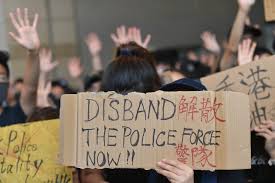
Some are calling for the dissolution of the Hong Kong cops – an impossible demand this side of a revolution, but healthy: the realisation of the 2014 student umbrella rebellion mirroring May ’68 in France with their slogan – “Soyez realiste – demandez l’impossible!”.

我们自己奋斗吧
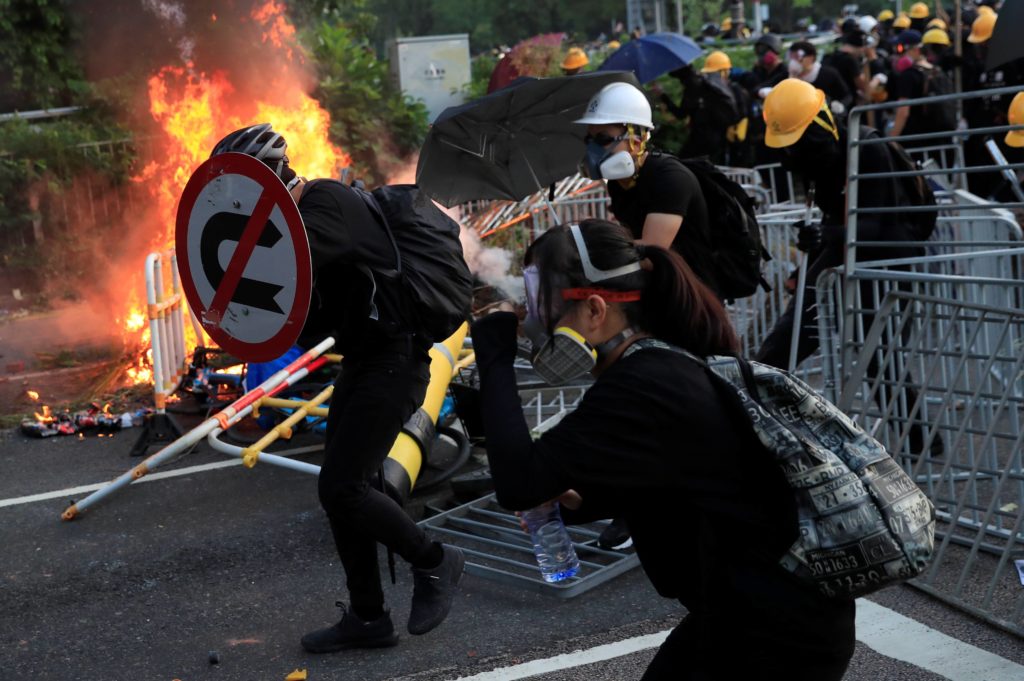
More here “Hong Kong protesters threw petrol bombs and police fired tear gas in street battles across the city …Police fired water cannon and tear gas to try to disperse protesters throwing petrol bombs outside central government offices in the Admiralty area of Hong Kong island and ordered the evacuation of the Legislative Council building, trashed by activists weeks ago, next door. In the New Territories town of Sha Tin, police fired tear gas canisters directly at high-rise windows, though it was not clear why, as the Chinese-ruled city was gripped by the most widespread violence in nearly four months of unrest. Police said “rioters” had used corrosive fluid in Tuen Mun in the west of the New Territories, “injuring multiple police officers and reporters”. More here “At least 66 people were injured, four of them seriously, and over 180 people arrested, police said. The demonstrations also paralysed much of the city, forcing the shut down of nearly half its metro stations as authorities tried to prevent larger crowds reaching protest sites. The chaotic scenes over-shadowed a carefully-choreographed military parade and evening gala meant to celebrate China’s rise to global super-power status, and showcase the rule of strongman president Xi Jinping. The shooting of Tsang caused particular outrage in Hong Kong and around the world, with the UK calling the use of live ammunition “disproportionate” and Amnesty International calling for an urgent independent investigation.”

Trump congratulates Xi on the 70th Anniversary of the People’s Republic of China
On the 70th anniversary of the People’s [sic] Republic of China, it’s worth reminding ourselves of the Tiananmen massacre. See particularly “The Meaning of Tiananmen” . This received a disclaimer from libcom’s admin on their utterly compromised site, a sign that the article is almost certainly worth reading. The disclaimer claims that the article has factual inaccuracies, but they can’t be bothered to give even one example of an inaccuracy (there is one – it talks of 1989 as being 30 years after the CCP took power, when it’s 40 years, but that’s more an easily recognised slip of calculation rather than an inaccuracy). Re. this libcom version, the author, Burt Green, writes:
“The version of my 2004 essay The Meaning of Tiananmen on the libcom.org website doesn’t have the graphics or the footnotes with which it was originally produced, and it was pubished without my knowledge or approval.
To compare this piece with that of Katsiaficas, who, years later in 2012, attempts to (re)tell a much longer story of the event, shows what is at best, the bad judgement of Nao and of their obliging hosts at libcom.org, who, in all liklihood, simply took Nao’s evaluation as given without troubling to look too deeply themselves.
The two pieces of writing were never attempts at the same object. I wrote my little essay as a reaction to the plethora of books and articles which had come out at the time (among them the crucial text of documents reflecting the struggle within the CCP leadership that concluded in the decision to massacre, The Tiananmen Papers), without, as I saw it, adequately assessing the novelty, profundity, or global implications for social contestation, of the movement whose eruption had led to a crisis of Chinese bureaucratic capitalist power. I took for granted that there was already a great deal of factual material that had been made public by well-informed scholars and witnesses for those who cared to inform themselves in detail as to what had happened, and deliberately kept my narrative of events to a near-absolute minimum, limiting myself to only what I thought essential to the support of my argument.
Katsiaficas, writing in another context, chose his approach to spare his readers the effort of investigating, or selecting from, the existing literature themselves.
My principle motivation was an ovewhelming frustration at the lack of a suffiently incisive analyses of the events presented in the existing stream of literature and the failure to draw conclusions which I felt were obvious, and so consequently I wrote a libertarian communist polemic. In it I put forward the thesis for the first time (as even Nao has had to admit) of the Tiananmen Square occupation as the advent of a new form of mass contestation expressed through the taking possession and self-organizing of social space (inspired to some degree, it must be admitted, by certain ideas in the first book by Kristin Ross on the Paris Commune). To put it another way, I wrote what I did solely to provide a weapon to the proletariat in its fight to abolish class society. “Burt Green” has no “name”, no credentials, no institution, and no career aspirations.
Katsiaficas’ motivation seems primarily to have been the pursuit of his academic and journalistic career, an impression not at all belied by the unoriginal and unrelievedly leftist presentation I had seen him give to promote his book at an anarchist book fair in San Francisco.
What I had written, bad self-proofreading (quite possibly a redundant term) notwithstanding, was at least in good faith – unlike what I suspect of Katsiaficas’ Dan Rather citation (which I had fortuitously caught off a live TV broadcast), like as not snatched from the beginning of my piece (which he never mentions) and inserted as one of three quotations at the head of his, a thing evidently beyond the notice or speculation of Nao or the site administrators. It should be additionally noted, and more firmly established, that libcom.org. itself, in its choice to put up without footnotes what I had written (if not for its silence on Katsiaficas’ eyebrow-raising choice in citing an estimation of June 4th casualties as “as many as seven hundred”), has betrayed an attitude toward the business of accuracy rather at variance with the strict disapproval registered in its unsolicited introduction to the piece it had elected to mutilate.
Altogether, in spirit, in execution, and in its goal, what I strove to accomplish was neither intended in the realm of journalism nor in the pursuit of some career, which is precisely where Katsiaficas’ work is for the most part situated. It is disappointing but not altogether surprising that Nao and libcom.org, both, would be unable, or unwilling, to tell the difference.”
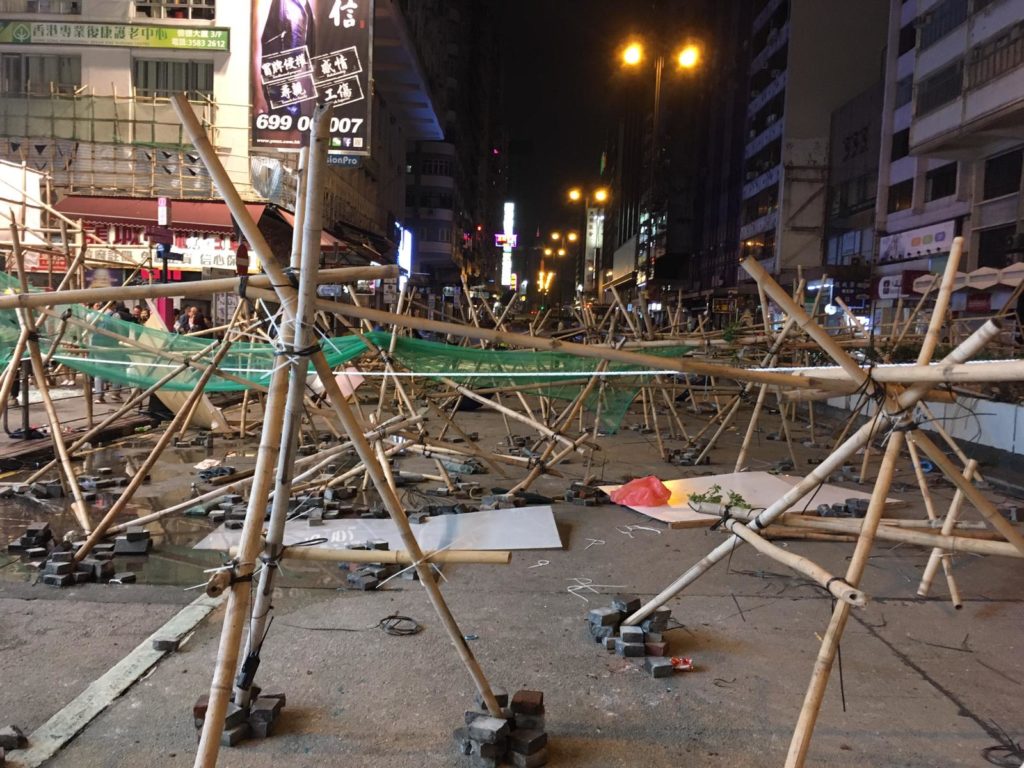

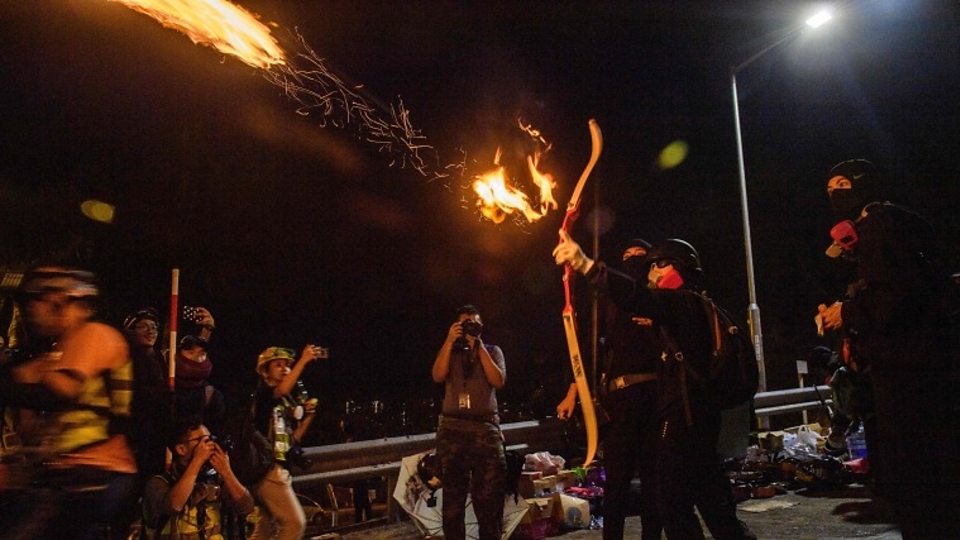

Leave a Reply